Meet the Top Graduates of FIT’s Class of 2021
Despite the size of the Fashion Institute of Technology, it’s possible to trace some common themes in the thesis work of the class of 2021. On one end of the spectrum are students who are interested in the intersection of technology, life, and fashion. Whether that was expressed with sleek futurism, or with more of a dystopian edge, it’s interesting to note that a cyber aesthetic can be achieved using earth-friendly materials. Another group of grads drew on their personal histories and experiences as they completed their final.
With school and studios closed and access to materials limited, the students had to rely on themselves during their senior year, finding different ways to cope. In the end, most reported feeling empowered by finding creative solutions to the obstacles the pandemic put in their way. As they prepare to enter the industry, they are thinking much about sustainability and inclusivity, believing that fashion needs to expand its reach so that it can be a powerful tool of self-expression and representation for a broader group of people.
Here, the work of 12 FIT graduates.
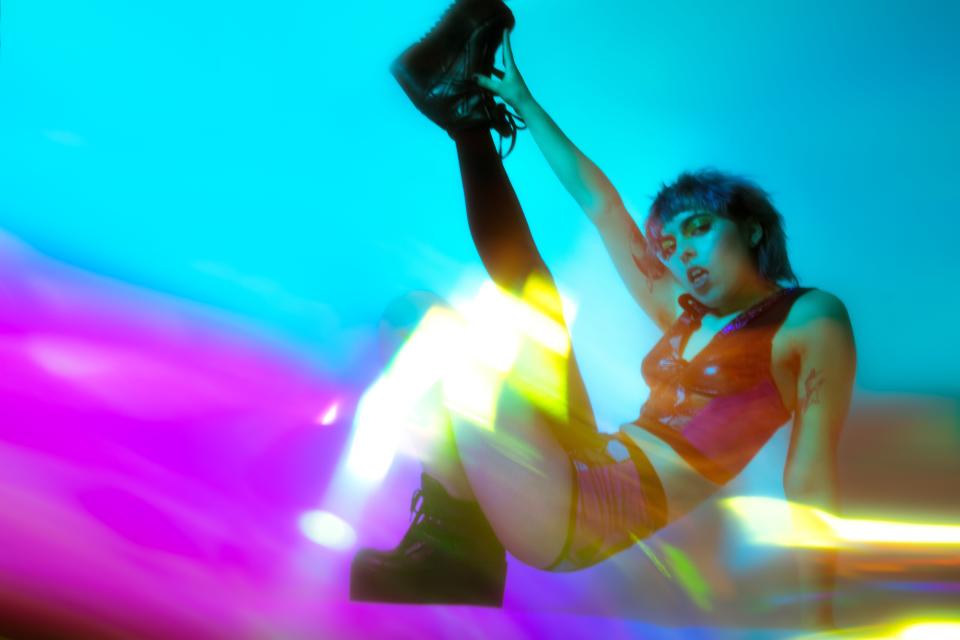
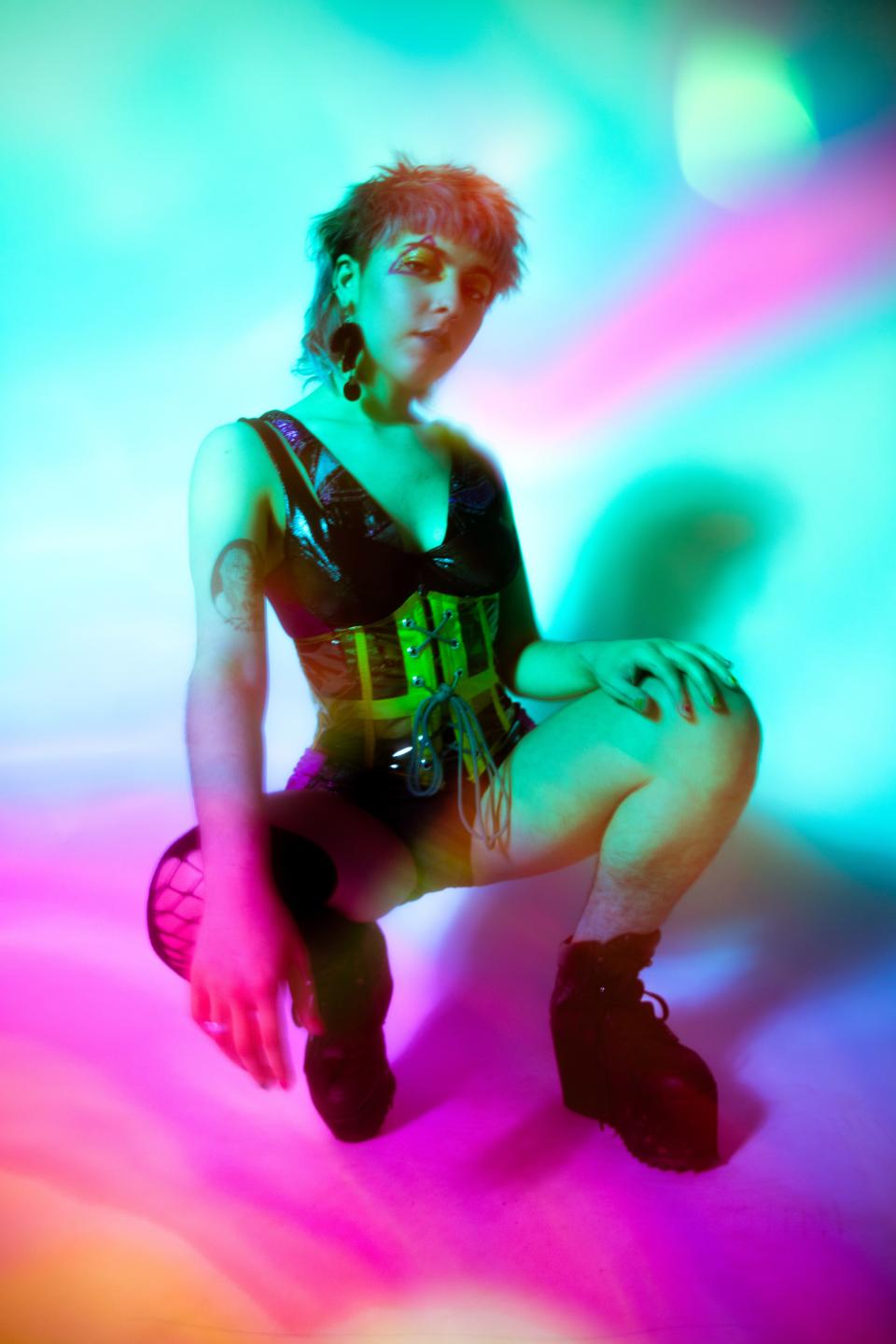
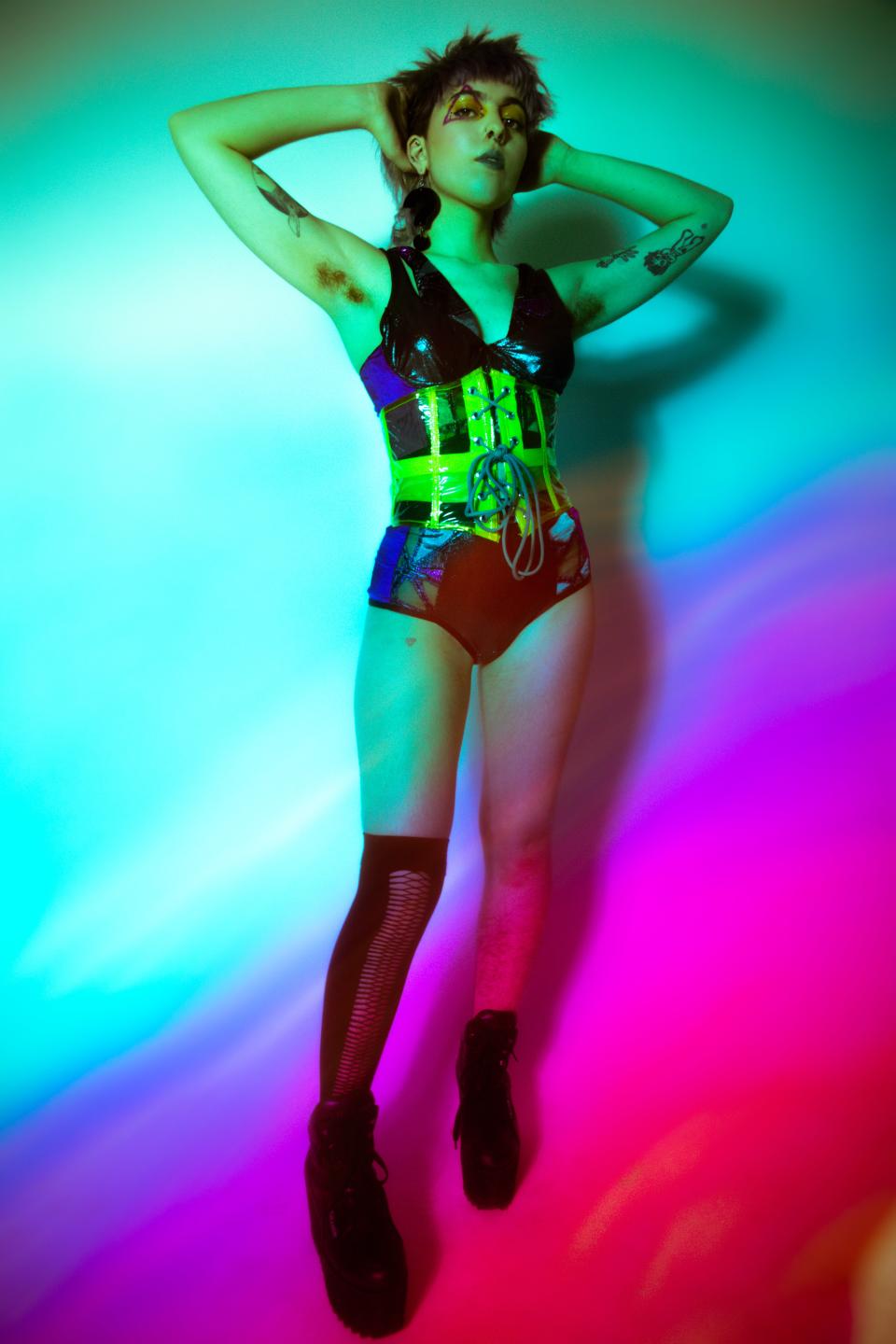
Rachel Angell, 21, from Frederick, Maryland; @an_angells_touch
Tell us about your look.
We live in a digital age, everything we do is online. I wanted to create a look inspired by a futuristic cyber dystopia. The bold yellow vinyl corset overlaying bra is paired with a high waisted panty made from metallic, teal knit, magenta spandex, and a geometric brocade. The bra is constructed with steel boning and underwire, and closes at center back with hook and eye tape. The corset is reinforced with steel boning and metal grommets at center front.
Describe your aesthetic in 140 characters.
Constantly evolving. I choose not to limit myself to one approach as I like to experiment by mixing colors, fabrics, and patterns.I take inspiration from all aspects of my life.
What challenges did you face in the pandemic, and how did you overcome them?
It was challenging to source fabrics, due to modified store hours and shipping times. Additionally, finding a model for an in-person fitting with a photographer to coordinate a photo shoot was difficult . My remote experience during the fall semester taught me to order fabric early to allow ample time for shipping. Also, when my original photographer fell through due to travel restrictions, I reached out to a colleague to model my look and for a referral to a photographer.
How would you like to change fashion, if you could?
Something that I have noticed across the board, but specifically in intimate apparel, is lack of inclusivity. For example, it is very hard to find size inclusive lingerie that is also sexy; or for a person of color to find nude undergarments that are actually nude on them. Even within gender, intimates, specifically lingere, is heavily marketed towards women, excluding the market of men or anyone who is gender non-conforming. Everyone deserves to wear something that makes them feel sexy, empowered, and supported.
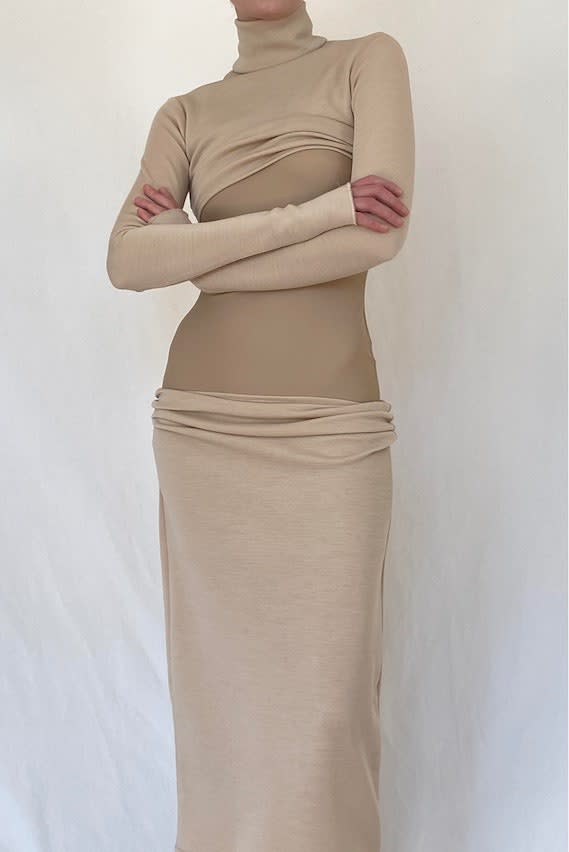
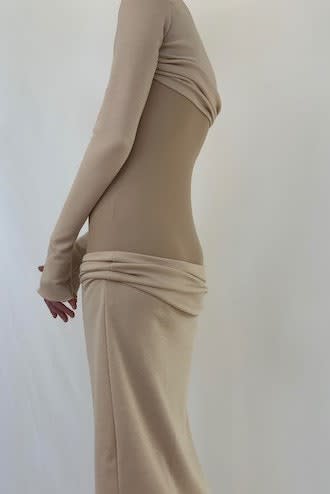
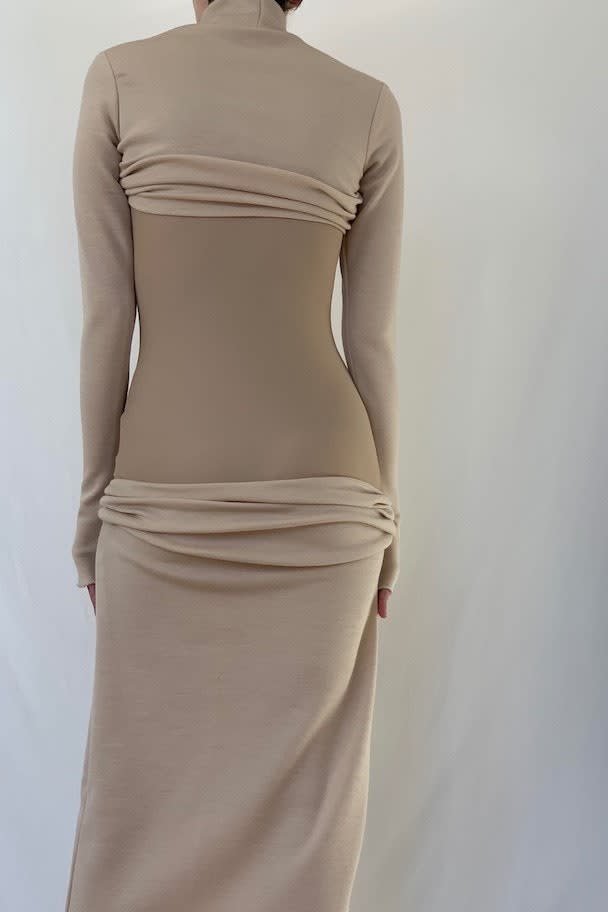
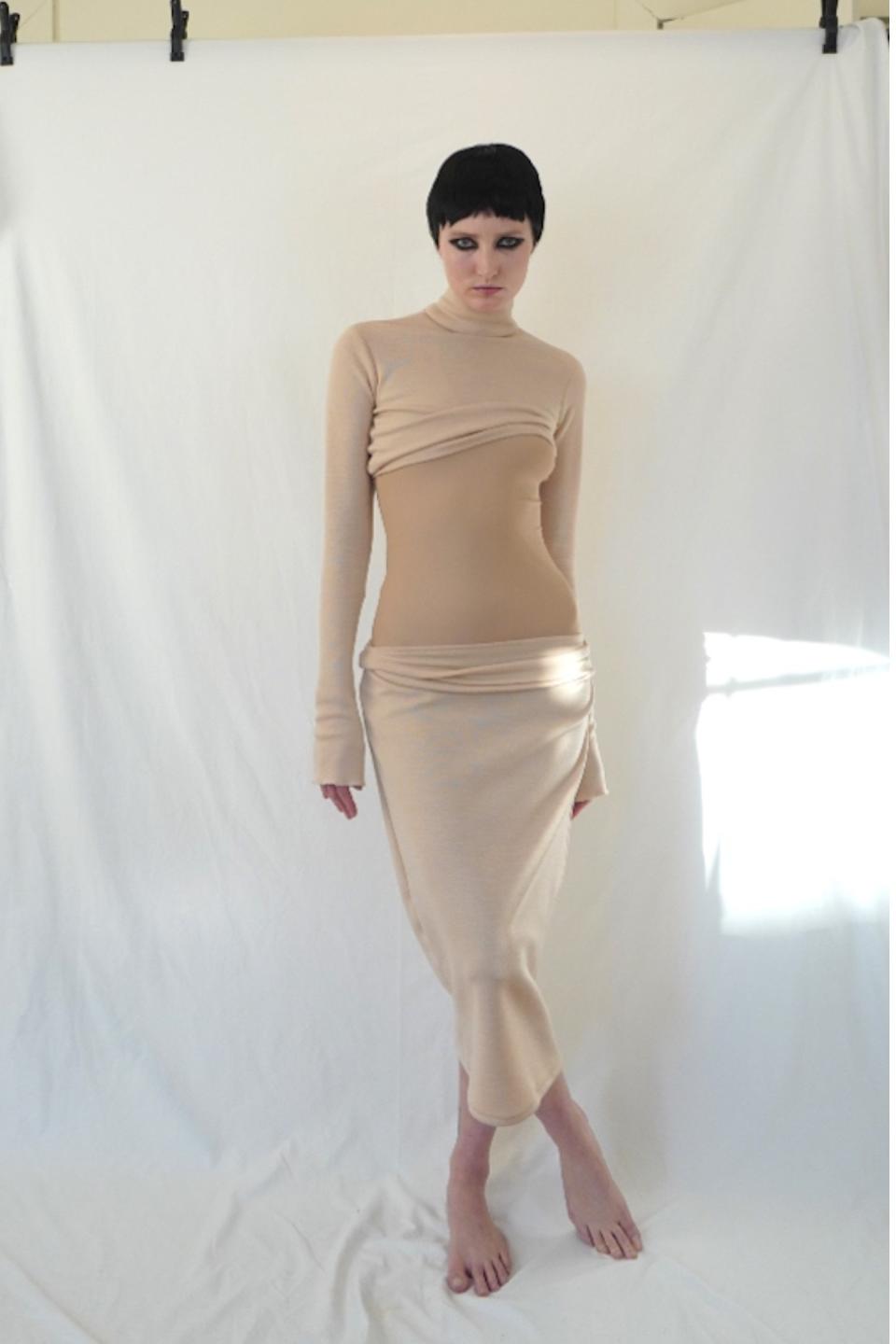
Abraham Azamy, 26, from Mission Viejo, CA
Tell us about your look.
The intention behind my garment is for the wearer to exude a subtle yet cheeky experience associated with undressing. I used a double knit wool for the mock top and skirt; both pieces are sewn at the neckline, armhole, and 10 inches below the waist; all to an underdress made from nylon Millikin spandex.
Describe your aesthetic in 140 characters.
An irreverent style that epitomizes the bold feminine spirit, with a discreet yet overt attitude towards dressing.
What challenges did you face in the pandemic, and how did you overcome them?
I had the opportunity to reassess my life and the relationships I had within myself. In May of last year, it dawned on me that with COVID-19, the world was now on an official pause and how I handled this free time was entirely in my own hands. Instead of questioning my abilities, I decided there was no room to be fearful.
How would you like to change fashion, if you could?
In terms of environmental ethics, I would encourage people to focus on how we should view clothing, and to adopt tactics to prevent contributing to the waste. In a capitalist society, when is it time to start educating consumers about how they should shop? This question alone would significantly impact the deceleration of mass production and encourage designers to approach their work more thoughtfully, all while creating timeless garments that can outlive today’s fast fashion trends. Going forward, we need to value our ideas and bring attention to word of mouth rather than relying on social media to mindlessly post everything all at once.
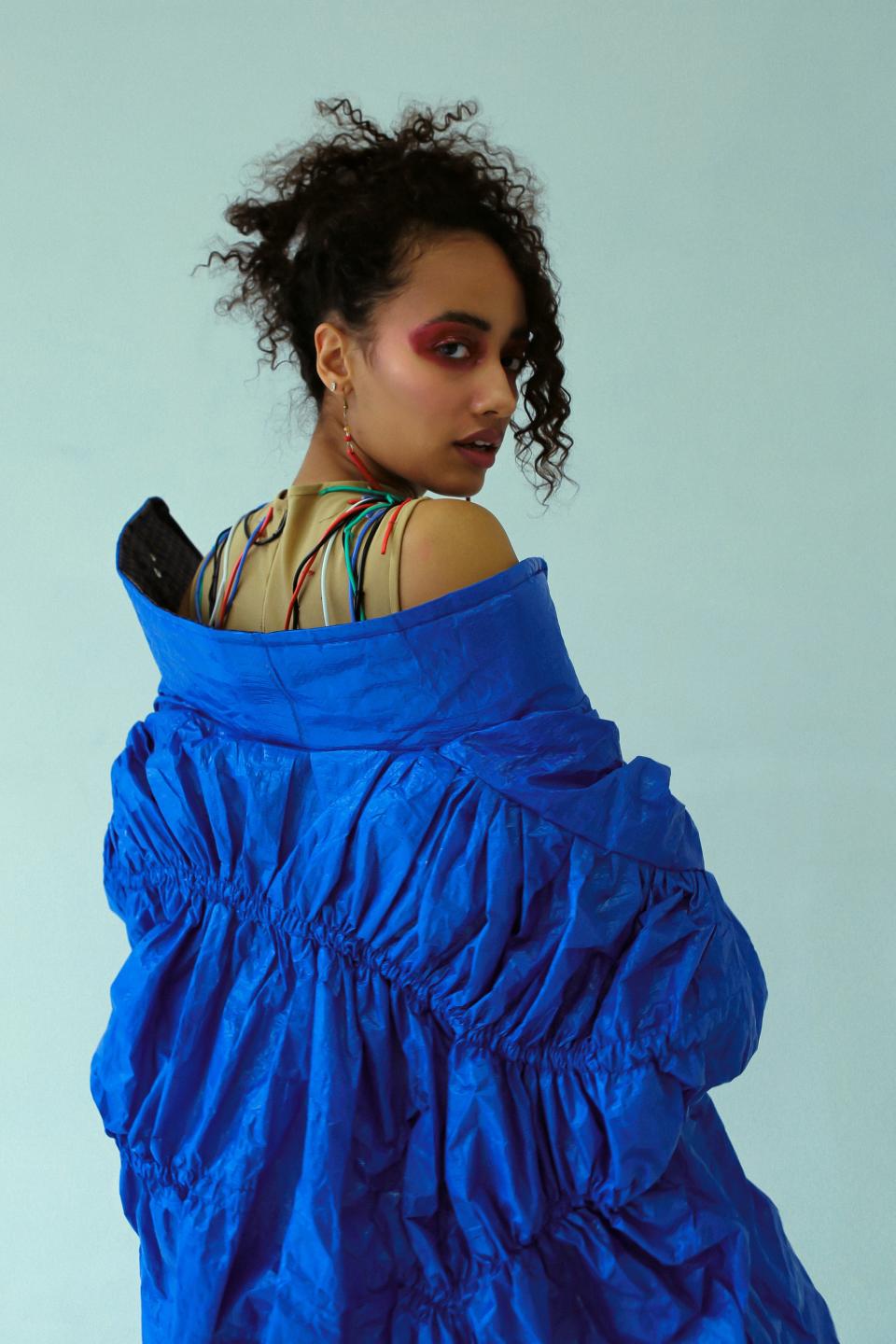
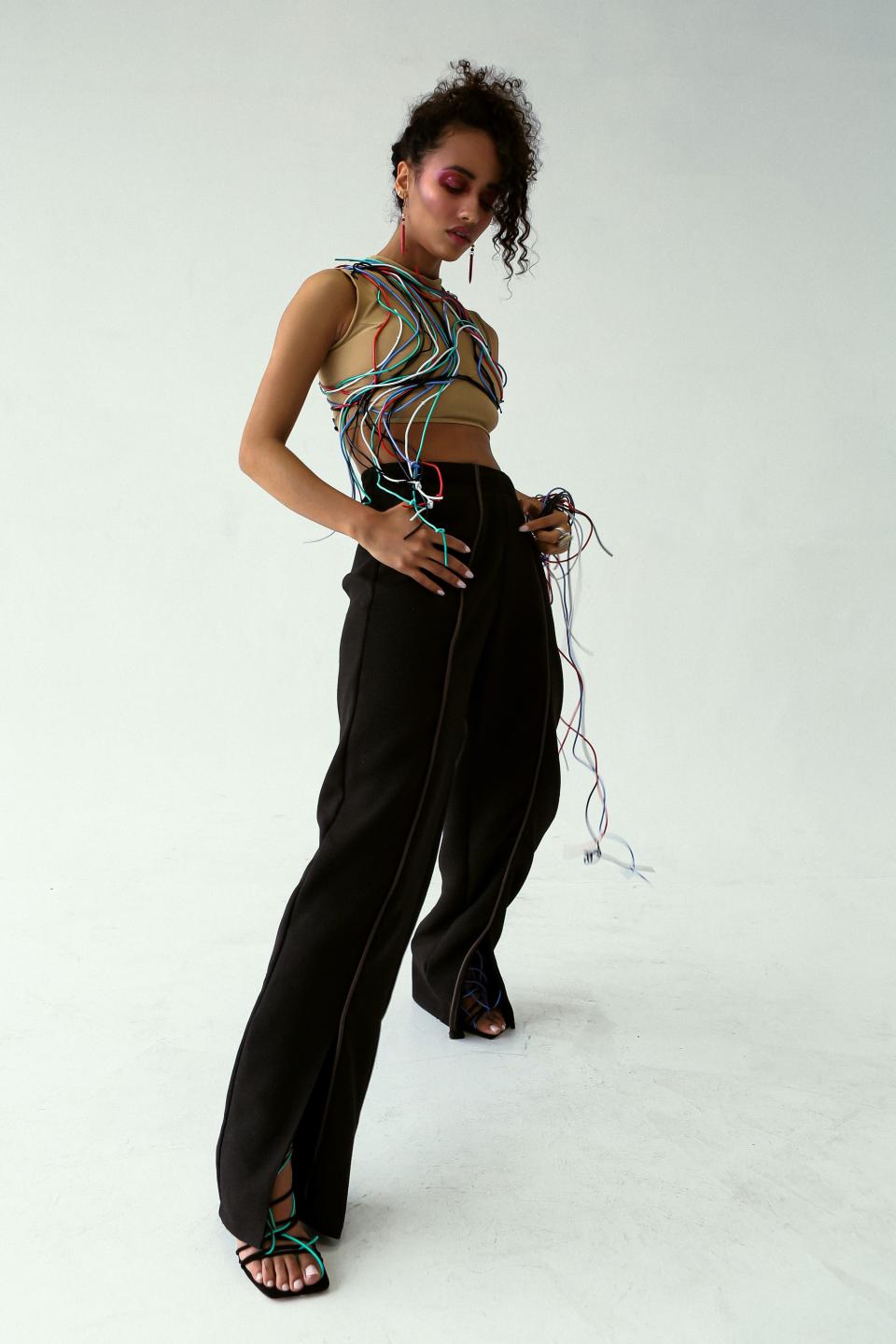
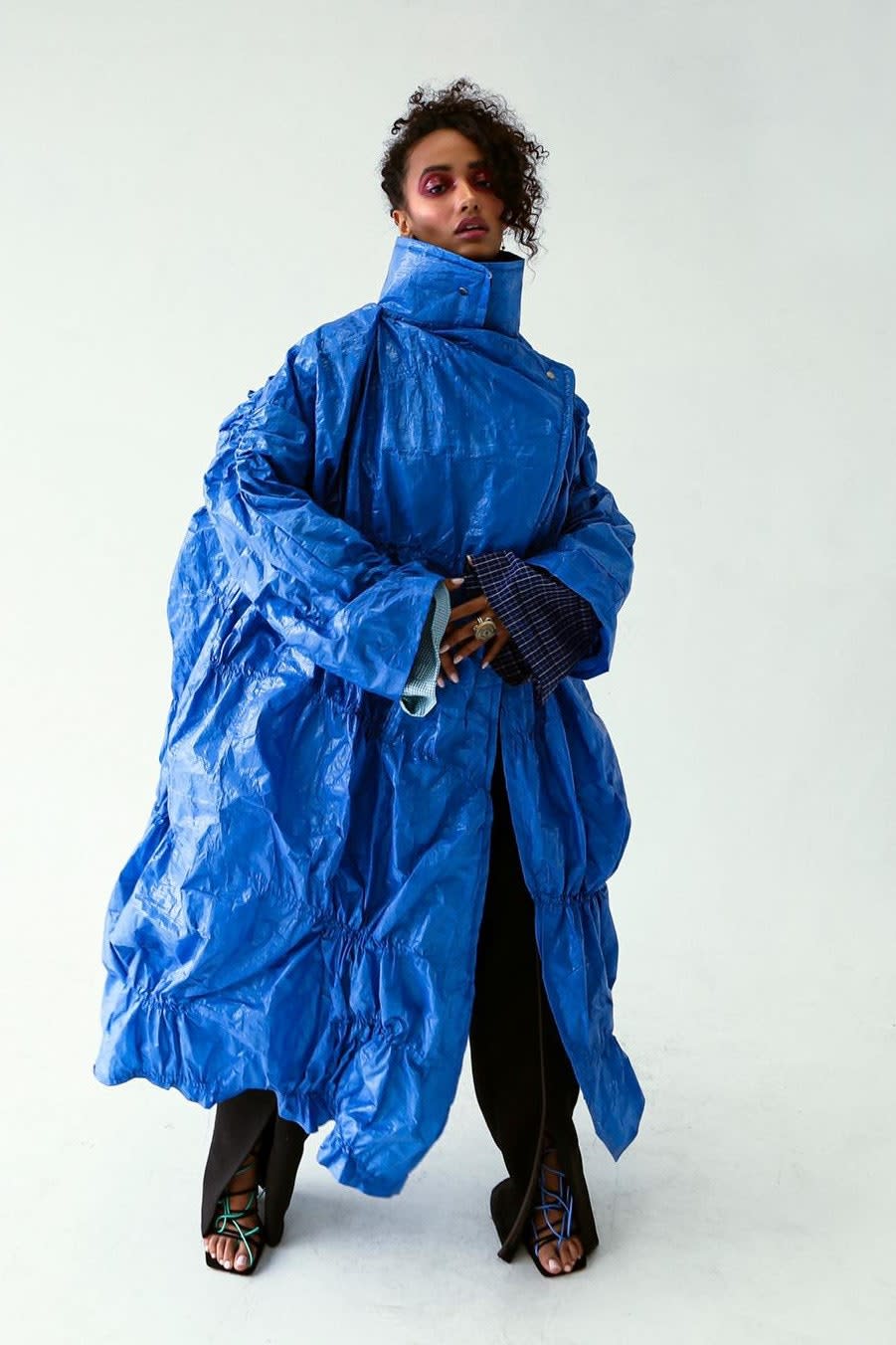
Valeria Flecha Rosa, 23, from Toa Alta, Puerto Rico; @valeflechaalabel
Tell us about your look.
My design consists of a three-piece ensemble inspired by the chaos and destruction caused by hurricane Maria and ongoing catastrophic events in Puerto Rico, but also by the resilience and resistance of Puerto Rican people. The first piece of the ensemble is a long impermeable trench coat made from recycled blue tarp. I manipulated the material by ruching the 8x10 foot plastic tarp to evoke the feeling of chaos, then cut and sewed it into a coat and lined it with patchwork of up-cycled button-up shirts. The second piece is a crop top made with a base of nude power mesh and topped with an appliqué of electric cables. The cables were hand basted into the top creating intertwined lines that symbolize the long-lasting electric outages caused by hurricane María in Puerto Rico, it also symbolizes the power of community and the importance of unity. The top is paired with a long loose pair of brown trousers that feature a faux leather piping detail along the princess line, a cutout on the left hip and an adjustable snap closure. All the materials used for the pants were recycled textiles sourced from the FabScrap organization.
Describe your aesthetic in 140 characters.
My aesthetic originates from all my experiences in life. I would best describe it as a juxtaposition of opposites; an expression of beauty in chaos.
What challenges did you face in the pandemic, and how did you overcome them?
At the beginning of the lockdown, I thought ‘At least I’ll finally be getting some rest,’ since I had been working and studying since I got to New York City in 2018. However, after a while it became overwhelming. I was stuck between four walls 24/7 and I had to create in the same room I slept, ate, worked, etc. [in]. It was tough finding creativity and the energy to be productive with so much going on in the world and the uncertainty of what was going to happen. I was emotionally drained for a long time. Additionally, I did not have most of the supplies needed to continue working.
I was in my head a lot, had a lot of time to think but this kind of helped. Having some time to disconnect from the world and reconnect with myself helped me redefine what was important to me and how I want to translate that through my art. I started working with what I had and shifted my creative process away from too many references and focused more on what I wanted to express, what was happening around me and what I was feeling. During that time, I started working with fabric scraps I had kept and eventually was able to get my own dress form. The creative block came and went during the pandemic, but after learning how to deal with it, I was able to find inspiration within the chaos.
How would you like to change fashion, if you could?
Although the fashion industry is slowly changing, there is still a long way to go. I believe fashion is a universal language, so it must be more inclusive, ethical, and sustainable. Fashion cannot continue at the expense of human rights and the exploitation of our environment.
As a designer, I would make these three ideas a core value of my brand: working to reduce my environmental footprint as much as possible; utilizing recycled and eco-friendly materials and practices; as well as making sure everyone working with us (from textiles to runway) are getting fair, living wages, and humanely working conditions. In terms of inclusivity, we should be able to see it in every aspect of fashion, not only in the runway or in advertising campaigns, but also behind the scenes, from designers and creatives to models. The fashion industry must offer equal pay and equal opportunities for everyone, no matter their race, gender, size, ethnicity, religion, socio-economic status, etc. Representation is highly important.
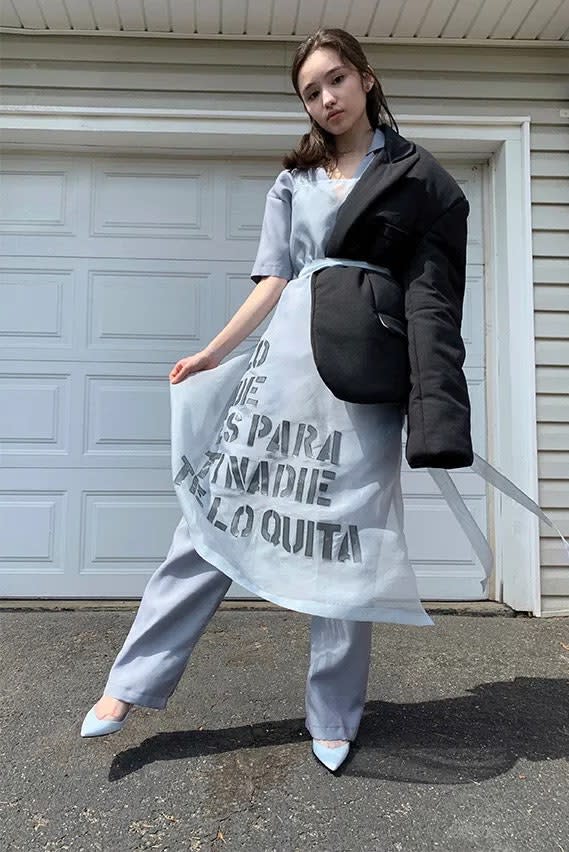
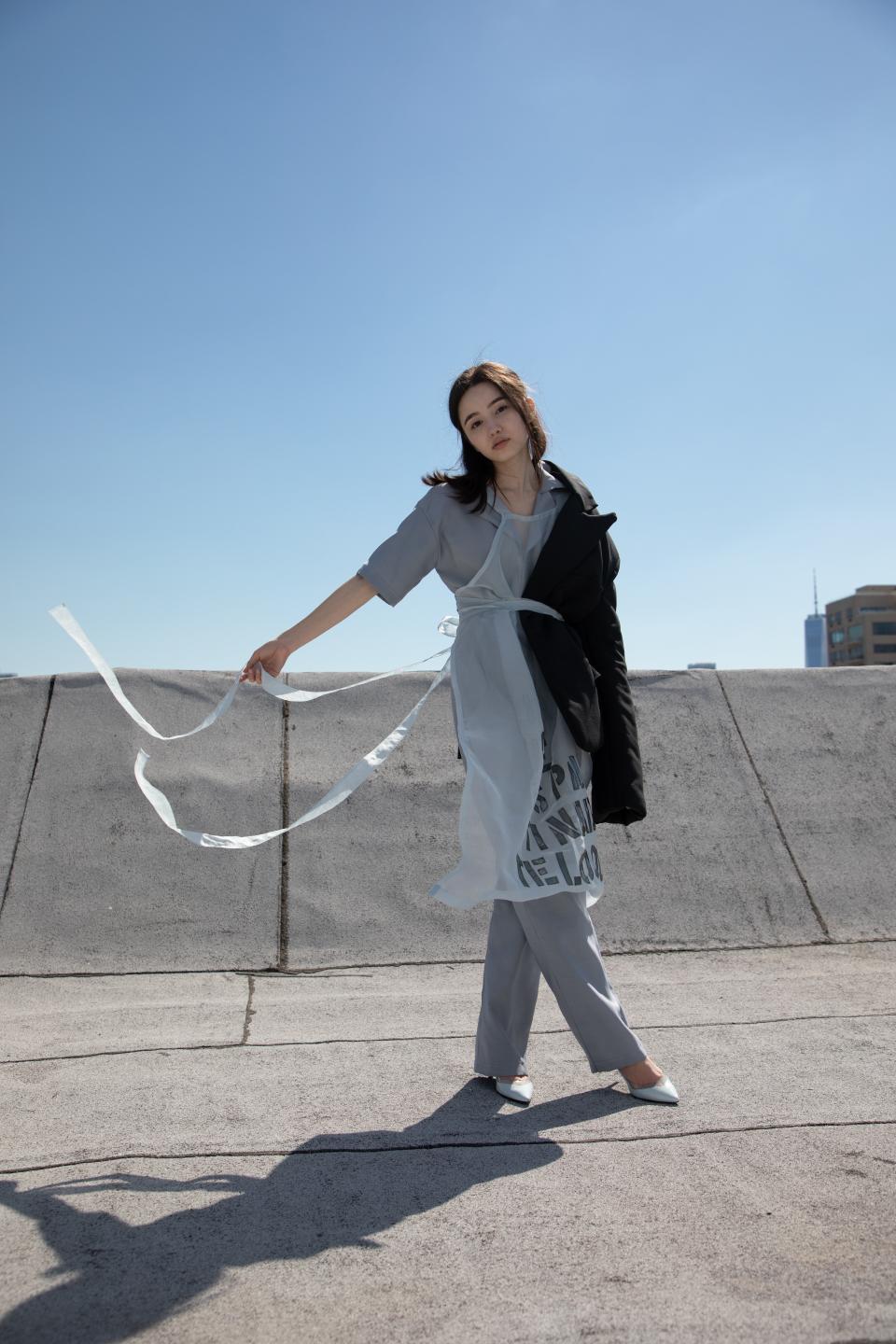
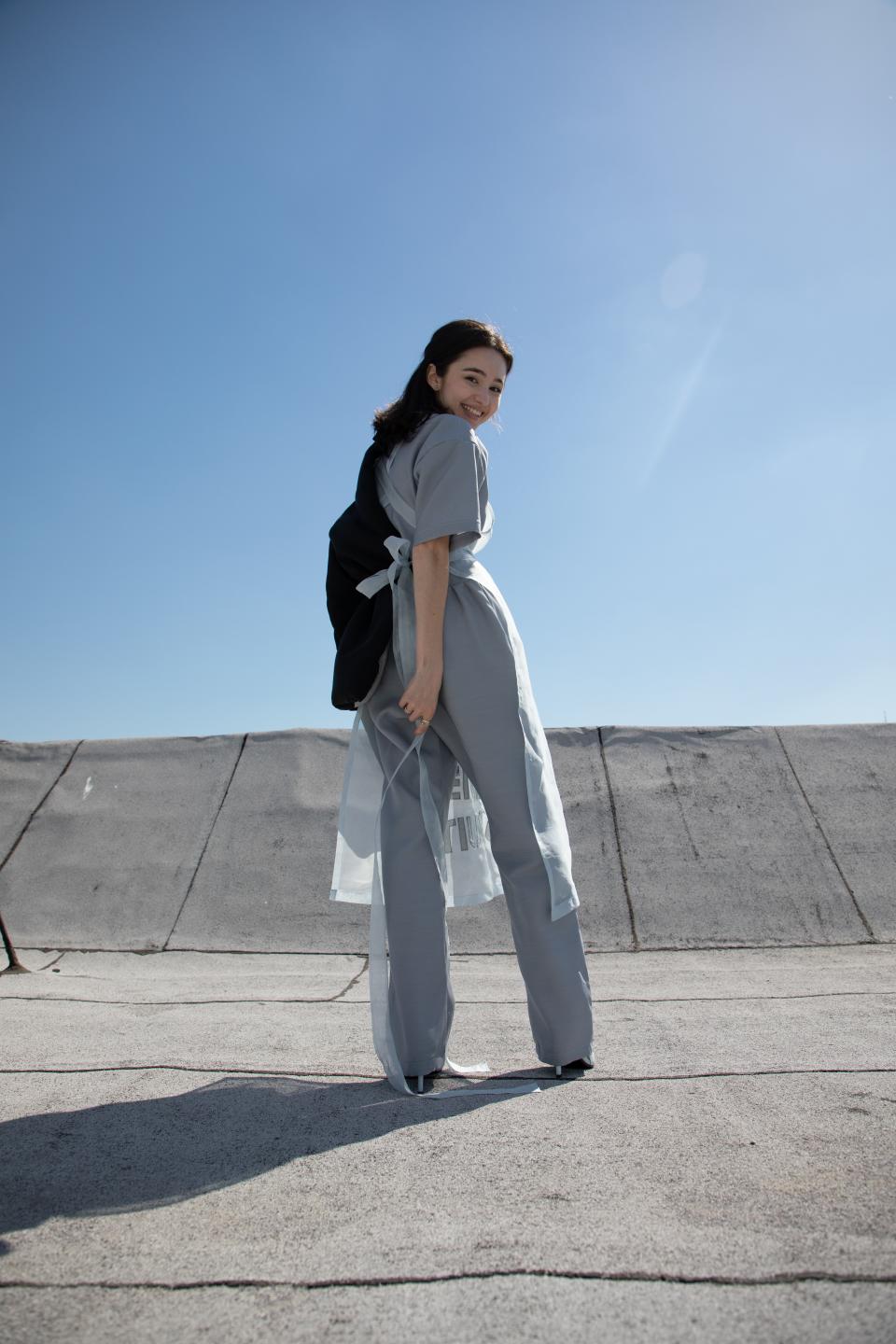
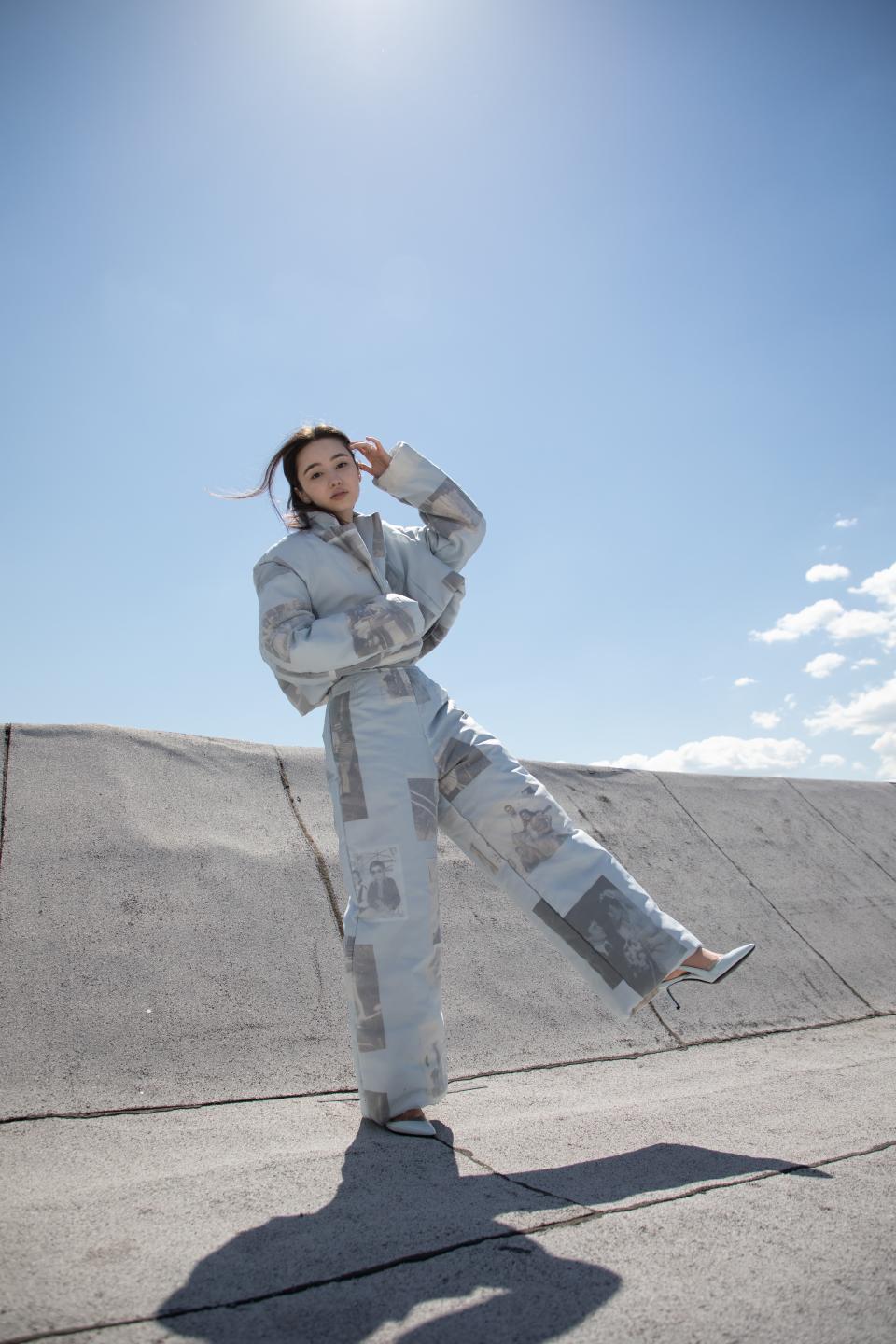
Mariana Gomez-Navarro, 21, from Cartago, Costa Rica; @marianagomezdesigns
Tell us about your looks.
[The first is] a silk wool coverall with a padded, wool, half-suit jacket, [and] a silk organza apron with PVC letters top stitched on it. [The second is] a padded, cropped suit jacket and pants made from a printed cotton twill fabric, topped with silk organza.
Describe your aesthetic in 140 characters.
Taking personal experiences that make up who I am and using them as inspiration for my work.
What challenges did you face in the pandemic, and how did you overcome them?
Having to work from home instead of in the studios was a challenge for me. It made me have to compact my work into a fold out table in the corner of my room instead of being able to work with my professors and peers in our classrooms. I took this challenge as an opportunity to work with what I have as a designer, which was myself. I feel that by having to rely more on my opinion and knowledge of my work has made me a better designer and helped strengthen my technical knowledge when it came to sewing as well as feeling secure in my choices.
How would you like to change fashion, if you could?
By showing genuine diversity in all aspects. I feel that representation through all different kinds of intersectionalities is essential for fashion. I like to tell people who I am through my work which for me includes being a Latinx immigrant. My hopes are that people, alike or not, can see themselves represented through my designs and that they provide everyone the opportunity to better understand themselves and others.
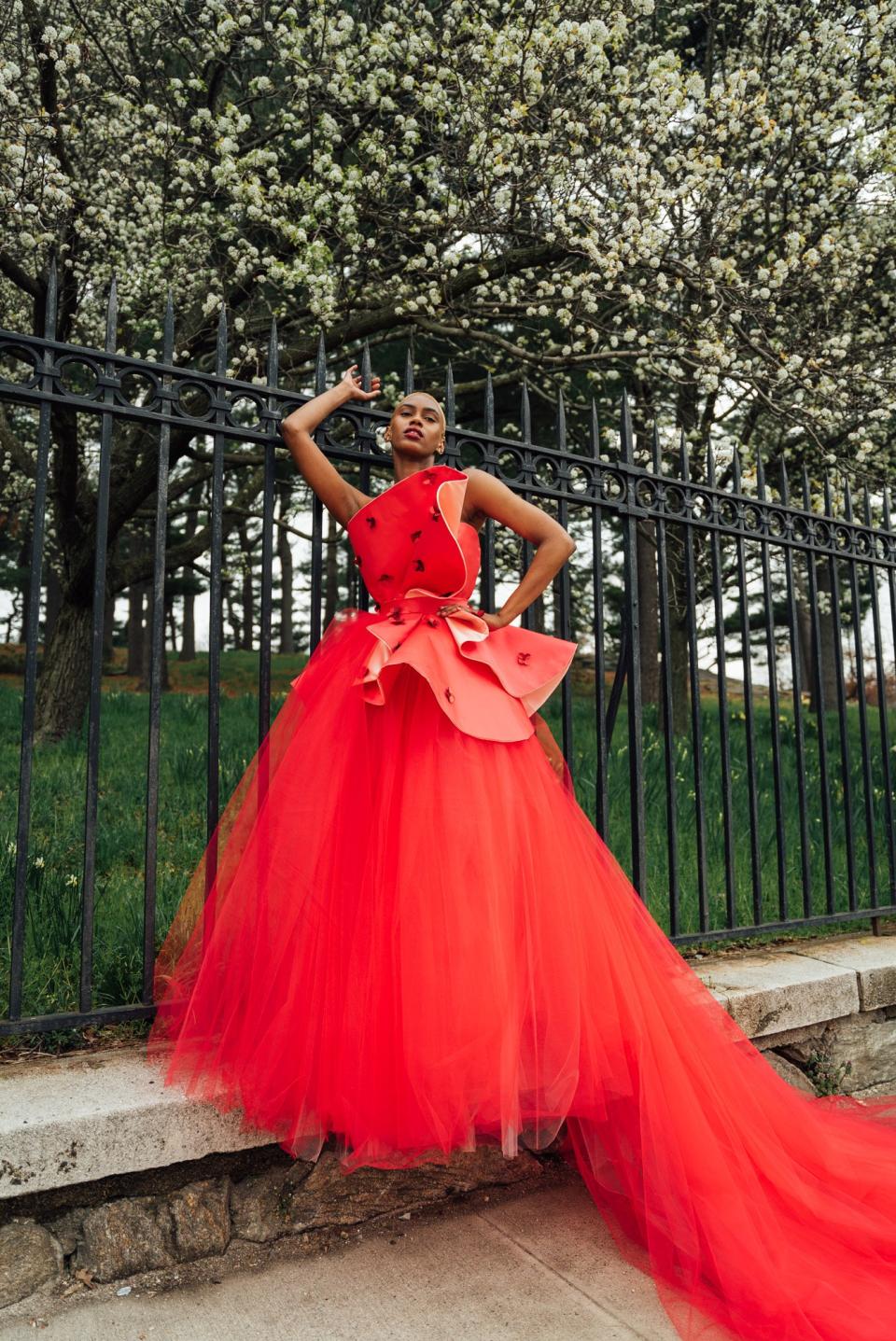
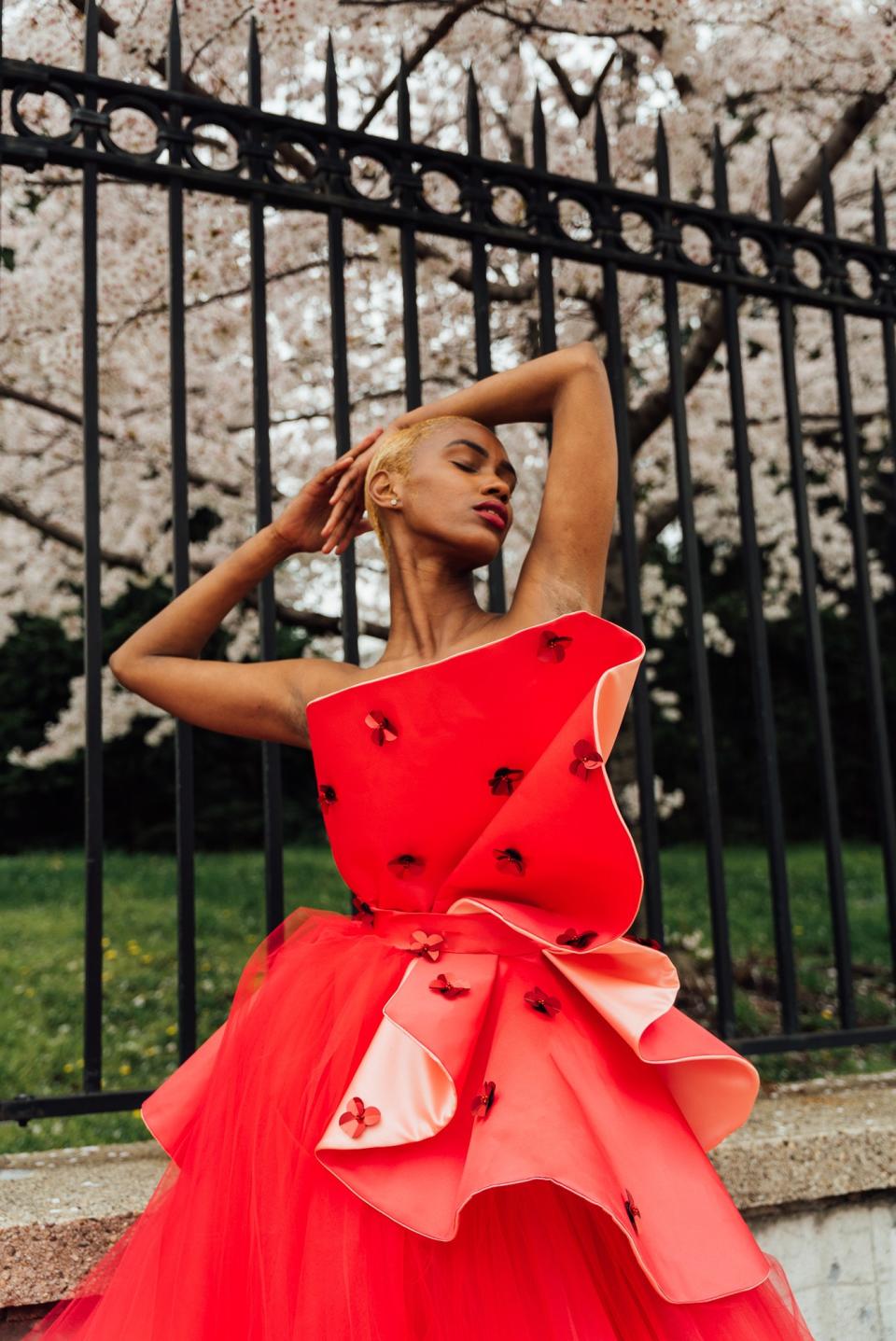
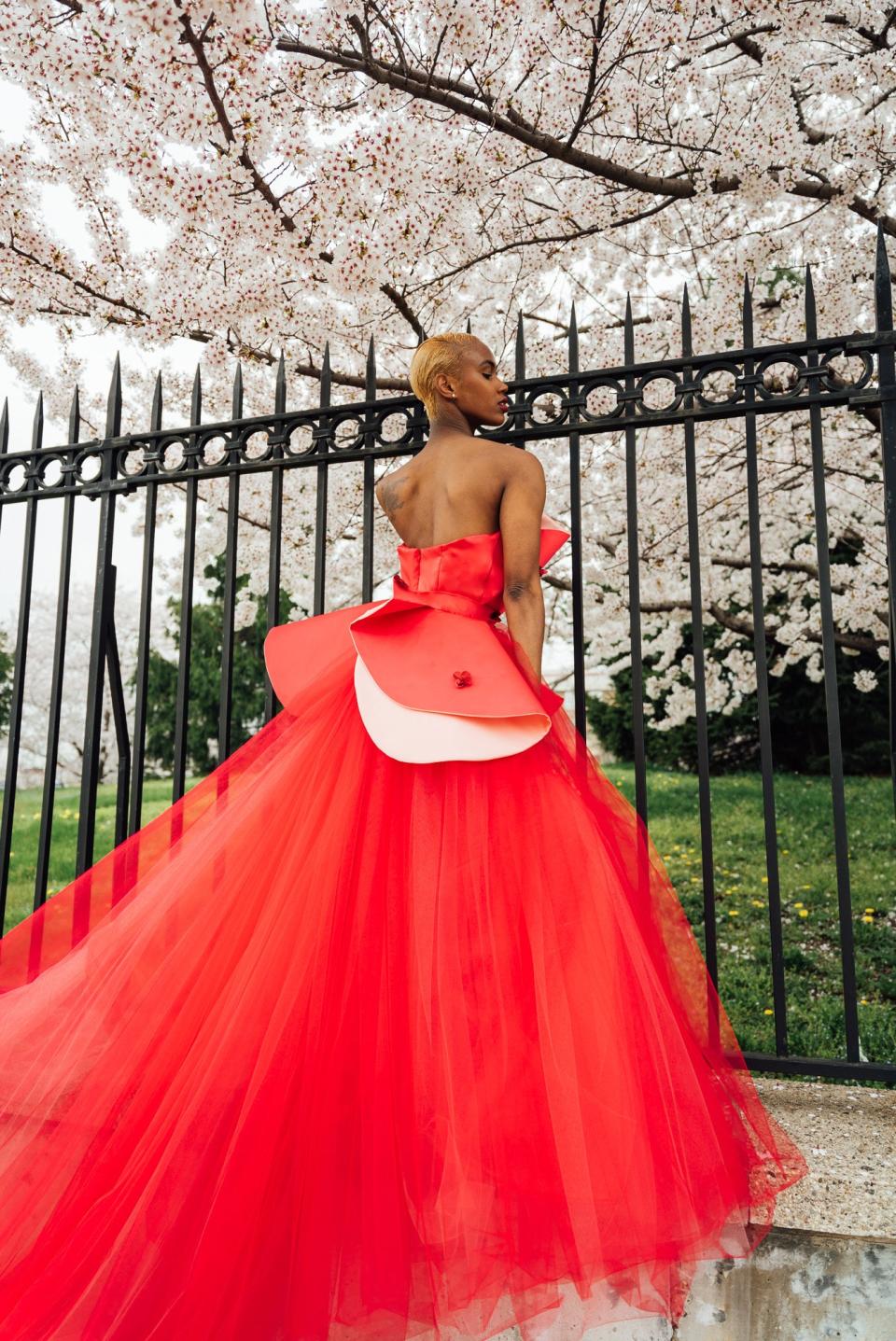
Amanda Hoffman, 21, from Manlius, New York; @nissanewyork
Tell us about your look.
I designed a red tulle gown with a long train. I used satin to create structure in the bodice and a removable belt piece to juxtapose the softness of the tulle skirt. I hand embellished the structurally draped satin with tonal beaded clusters, for a couture effect.
Describe your aesthetic in 140 characters.
My aesthetic is unique to the occasion. I enjoy using color in everything that I design.
What challenges did you face in the pandemic, and how did you overcome them?
The lack of a proper workspace, as well as the lack of equipment, was a huge obstacle. It was difficult to find materials as well. I decided to be productive with my time and formally launch my brand, Nissa New York. I went back home where I had more workspace and began to make pieces to sell. I created made-to-order pieces and then, as the demand began to increase, I decided to utilize contract manufacturing in order to increase production. Once school resumed, I headed back to NYC and began to design my thesis garment. When it came time to sew and construct, I found that my biggest challenge was the lack of space in my tiny apartment bedroom, with a sewing machine on a TV tray. When I was able to, I made weekend trips back home, [where] I was fortunate enough to have access to a local elementary school classroom, which was closed due to the pandemic. It was there I had ample room to cut out the pattern, cut the train and finish the embellishments.
How would you like to change fashion, if you could?
By building my brand with the goal of being more inclusive and helping everyone to feel confident and beautiful. As the brand grows, I plan to expand my size range. When selecting models I work with, I choose those that highlight the beauty of people from all demographics. I want everyone to be represented in my clothes. I want my clothing to make people feel amazing. I’d like to see the industry move to made-to-order production of clothing and for that business model to become more profitable.
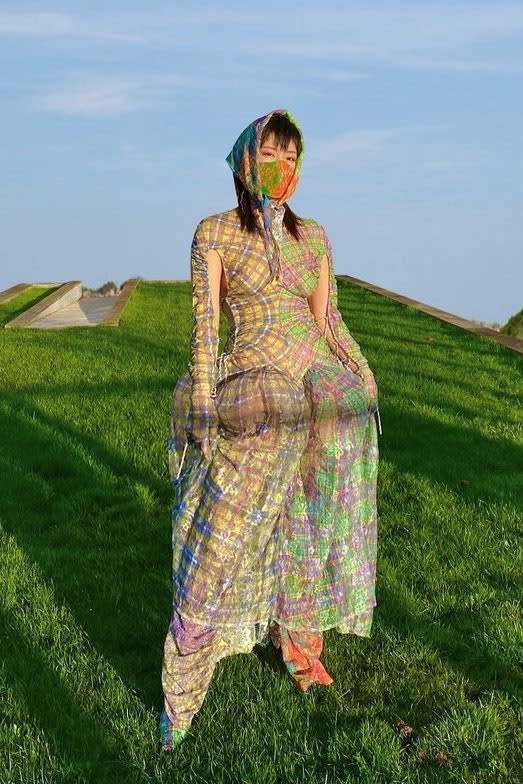
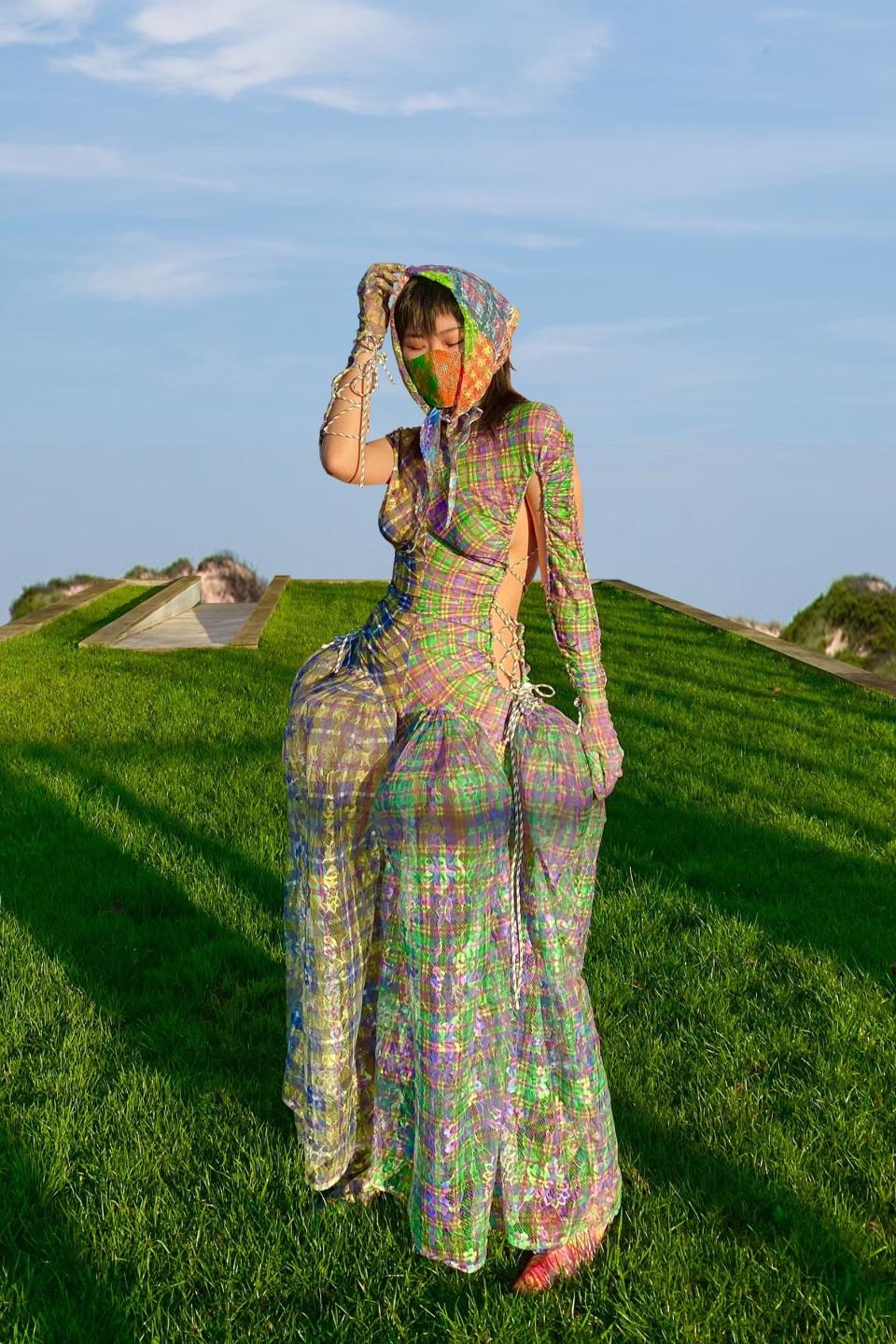
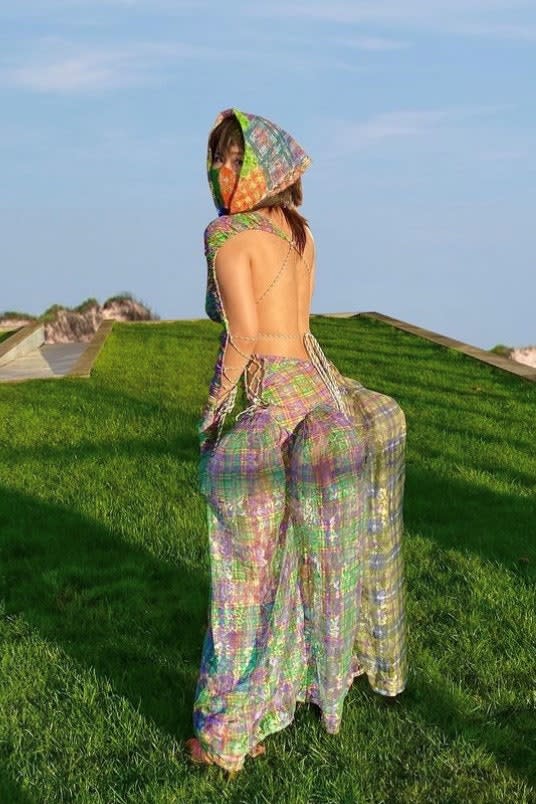
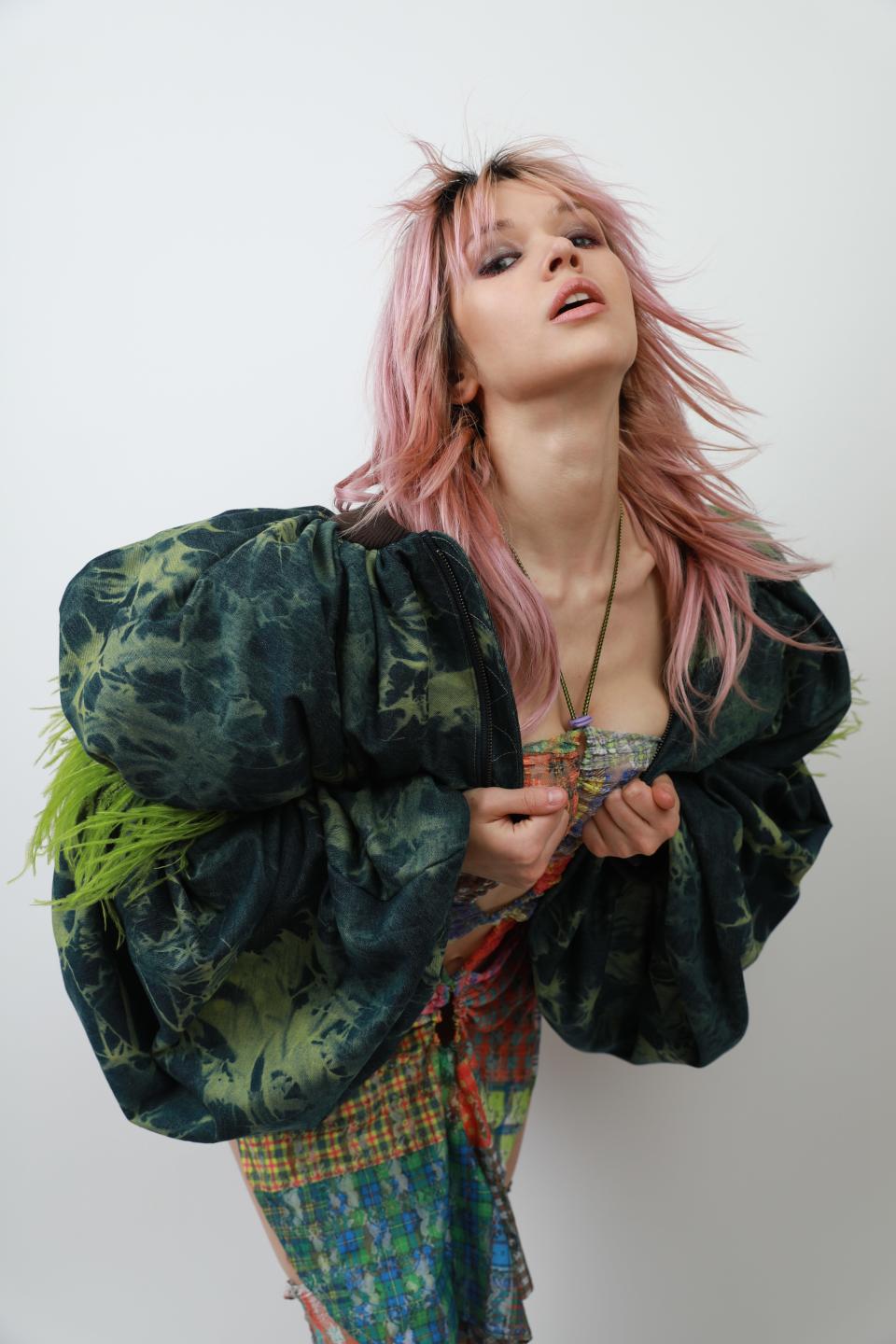
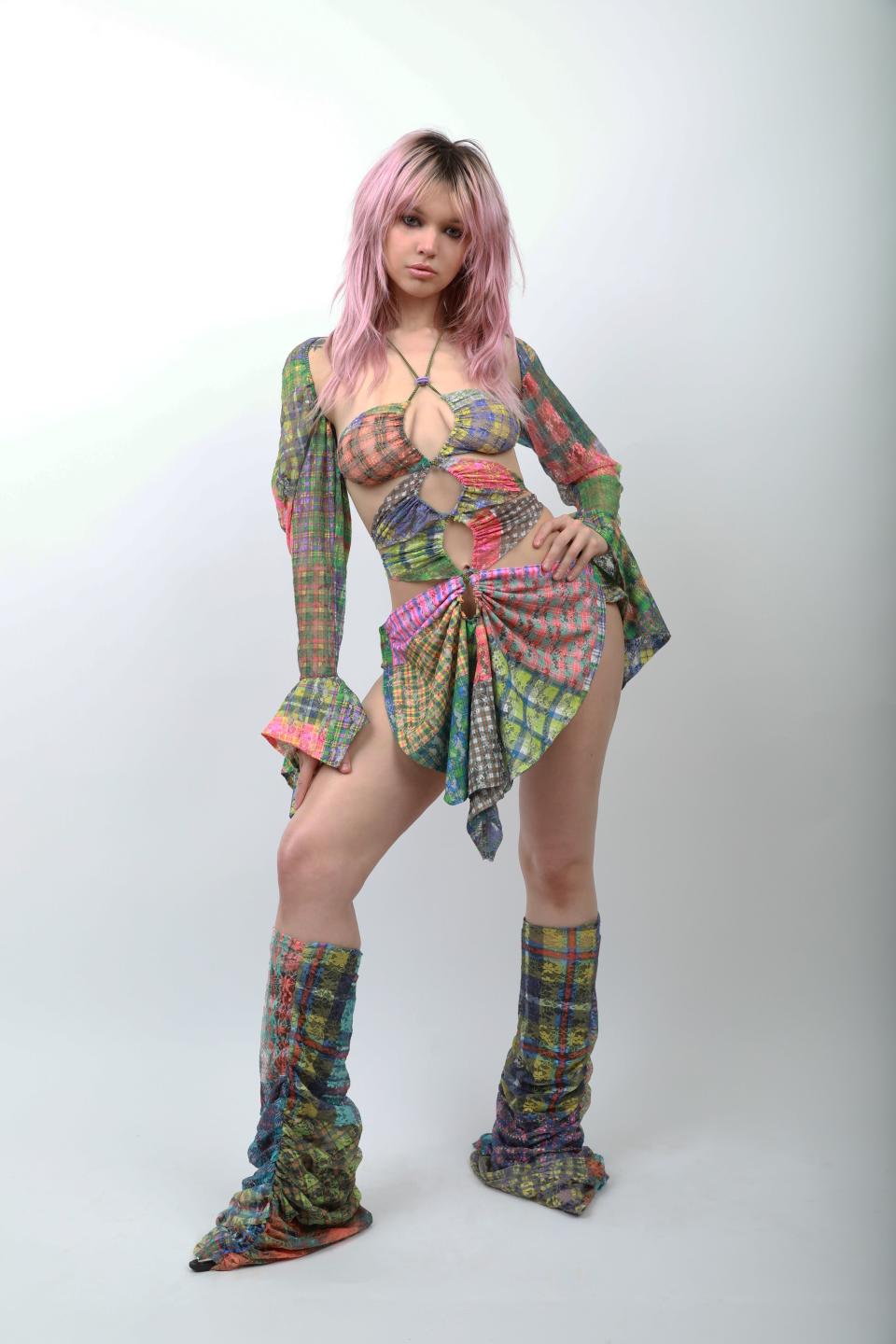
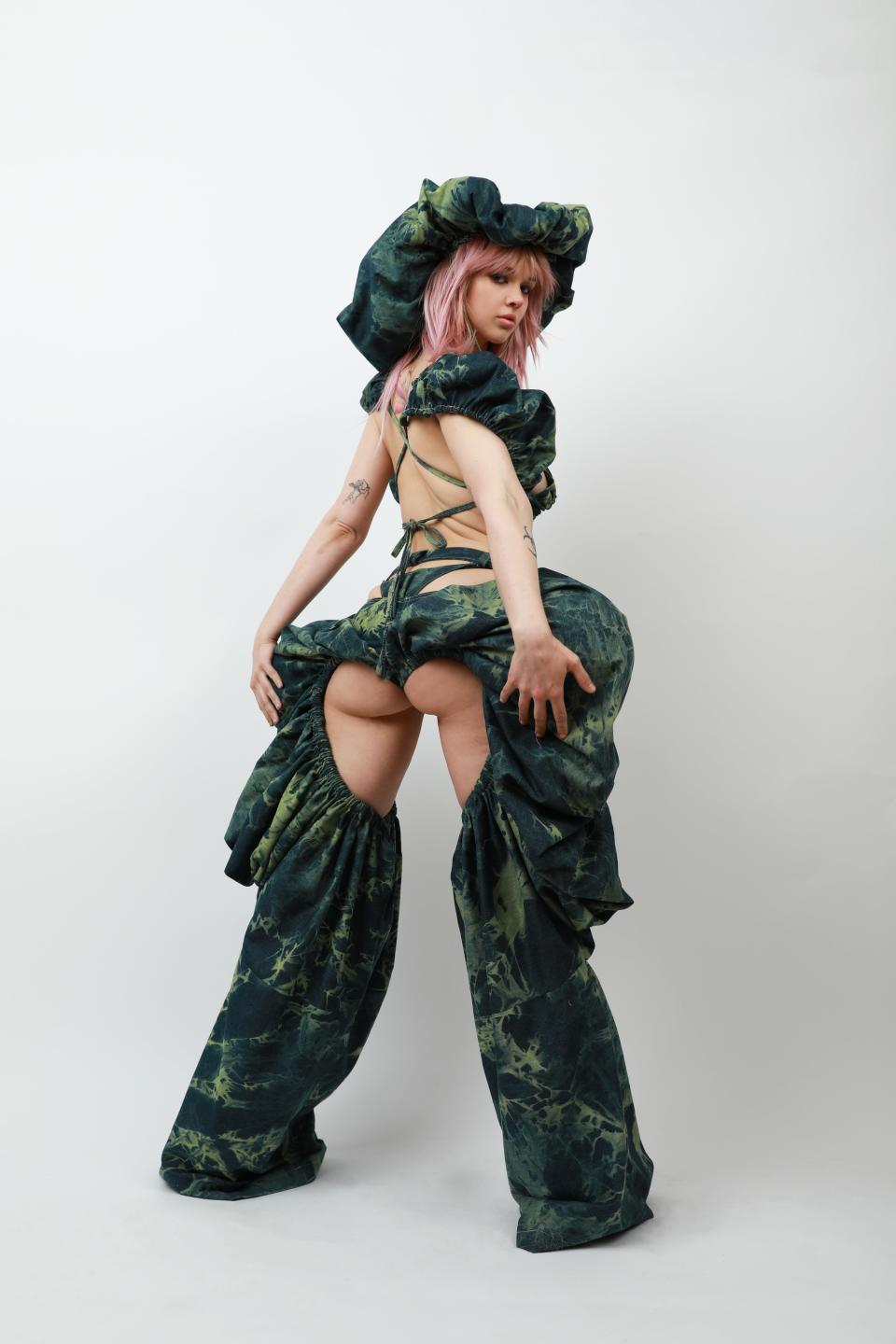
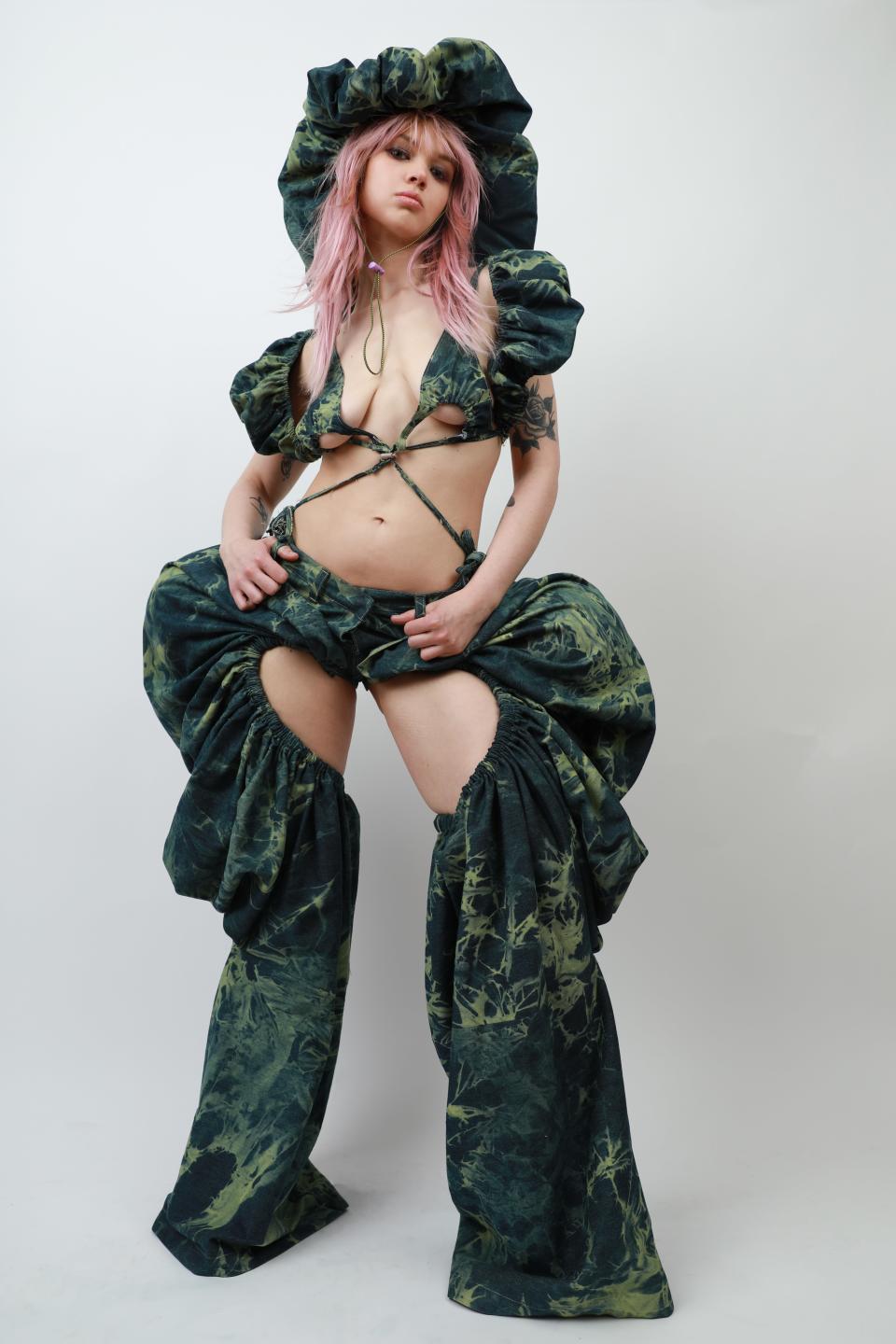
Yitao Li, 22, from, Taiyuan, China; @esthiliyt
Tell us about your looks.
The first look consists of a balloon dress, accessories, and customized boots all made of patchwork lace playing with different levels of transparency. The soft lace is structured at the hips to bring volume while still being lightweight and sheer, showing the leg warmers underneath. Look 2 is a heart shaped chaps pants, a butterfly top, and a hat made of tie dye denim, gathered around the legs. Look 3 is bungee cord lace patchwork cutout dress, leg warmers, and balloon denim tie dye jacket.
Describe your aesthetic in 140 characters.
I love to experiment and forge new ways of creating clothing. I like fun, playful, pop colors, experimental shapes, and also sexy!
What challenges did you face in the pandemic, and how did you overcome them?
Not having enough resources and machines to make things work fast like before, but luckily I’ve discovered many fabric treatments that only a home machine can achieve!
How would you like to change fashion, if you could?
I would love for fashion to gradually incorporate digital experiences, more technology for the wearer.
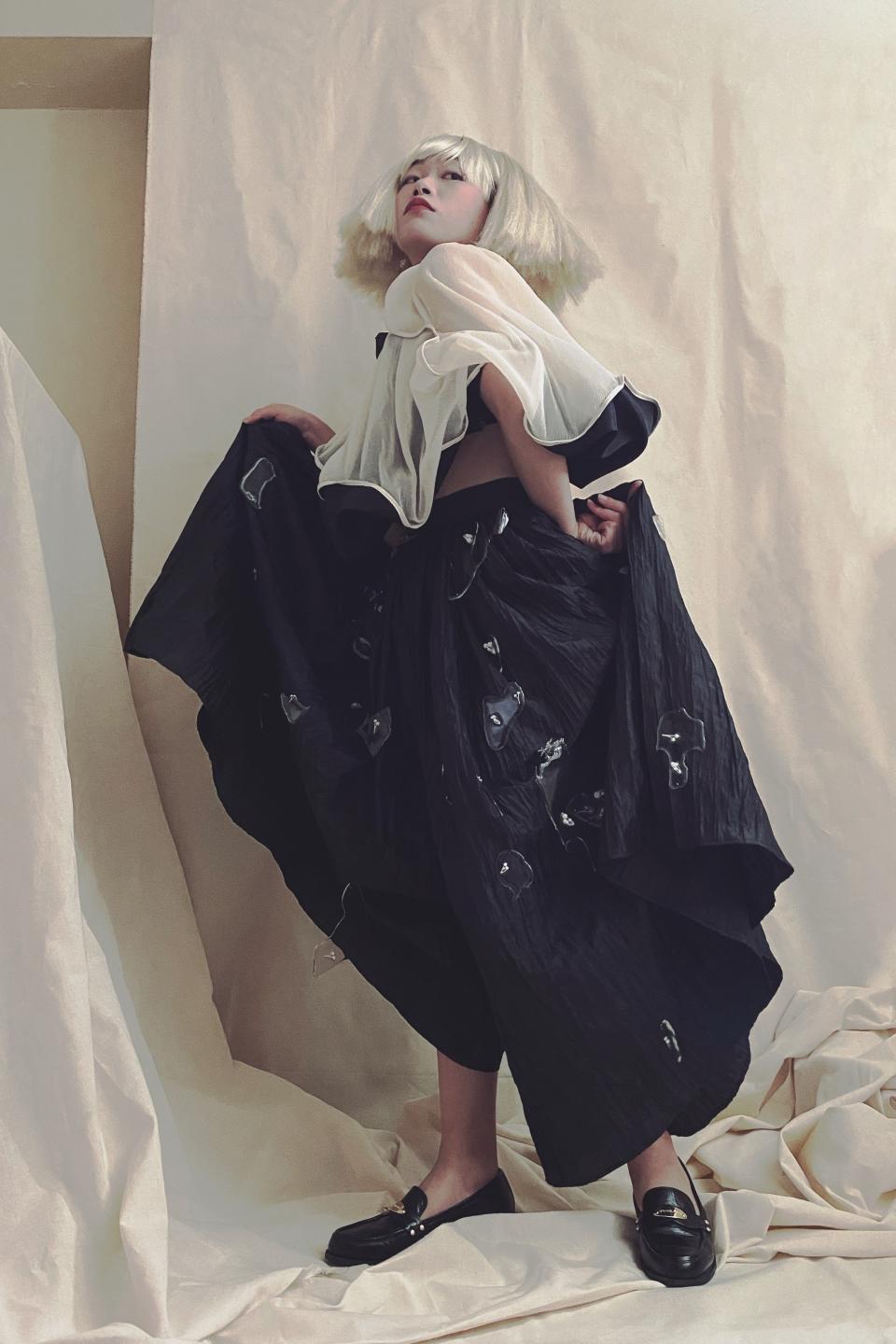
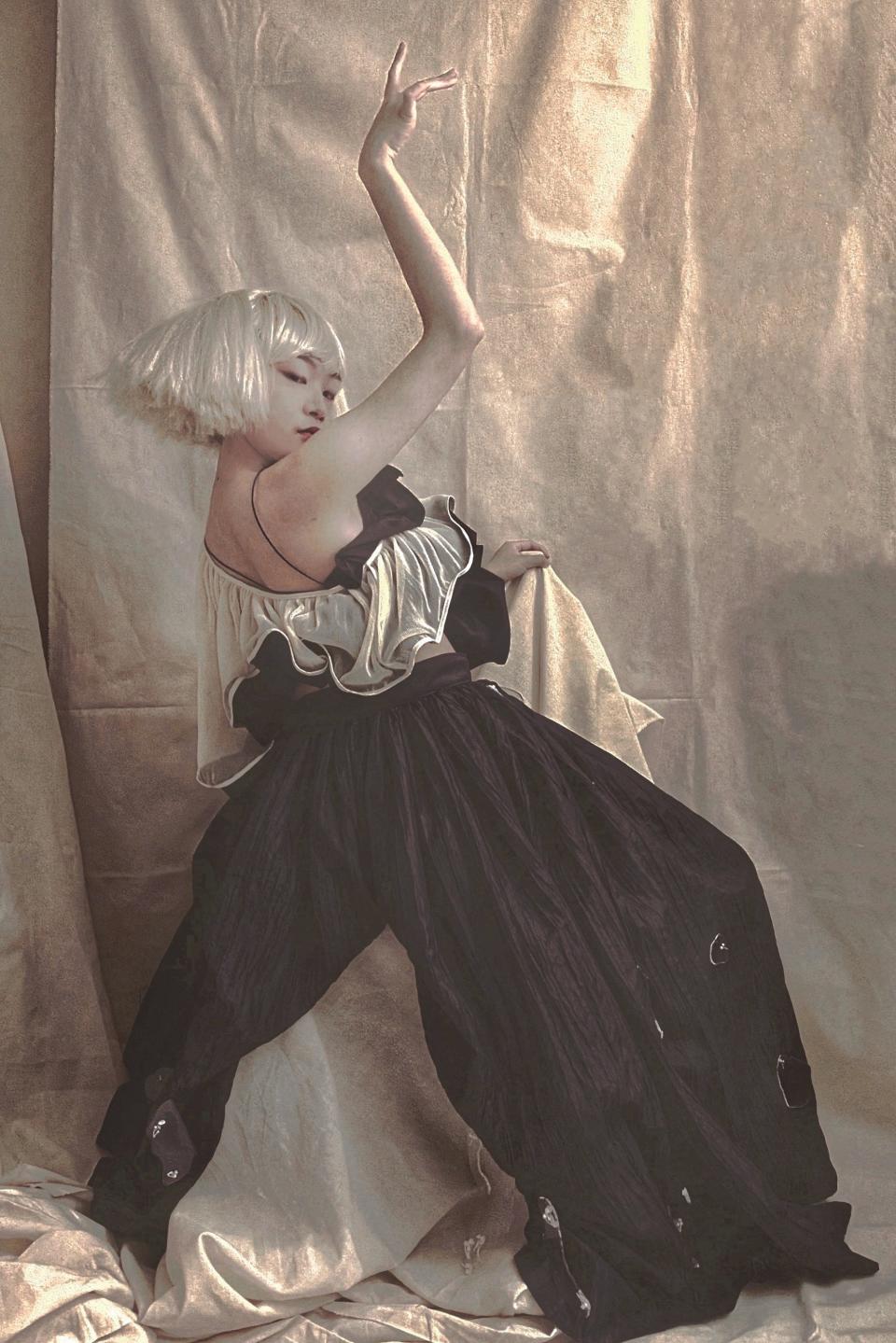
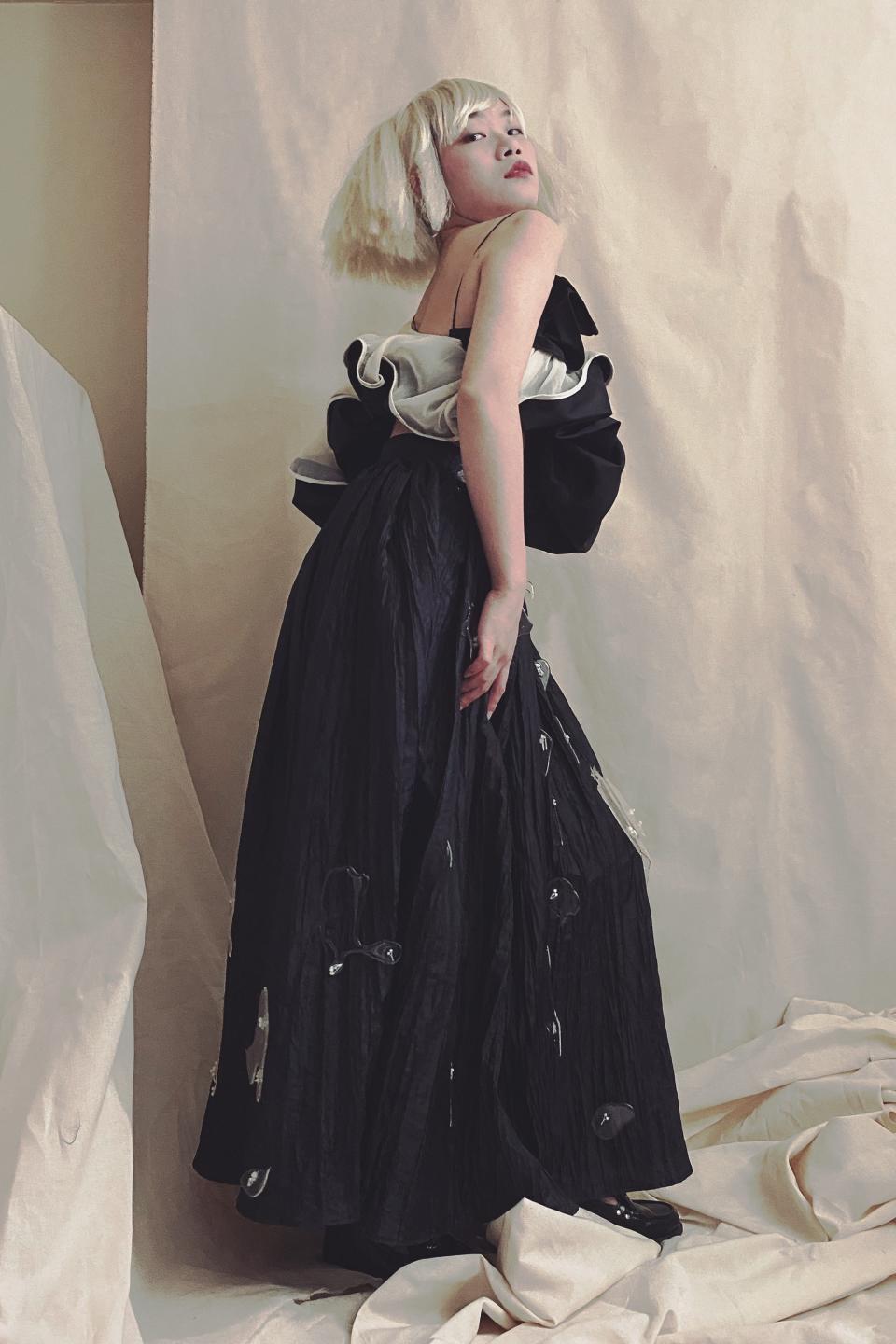
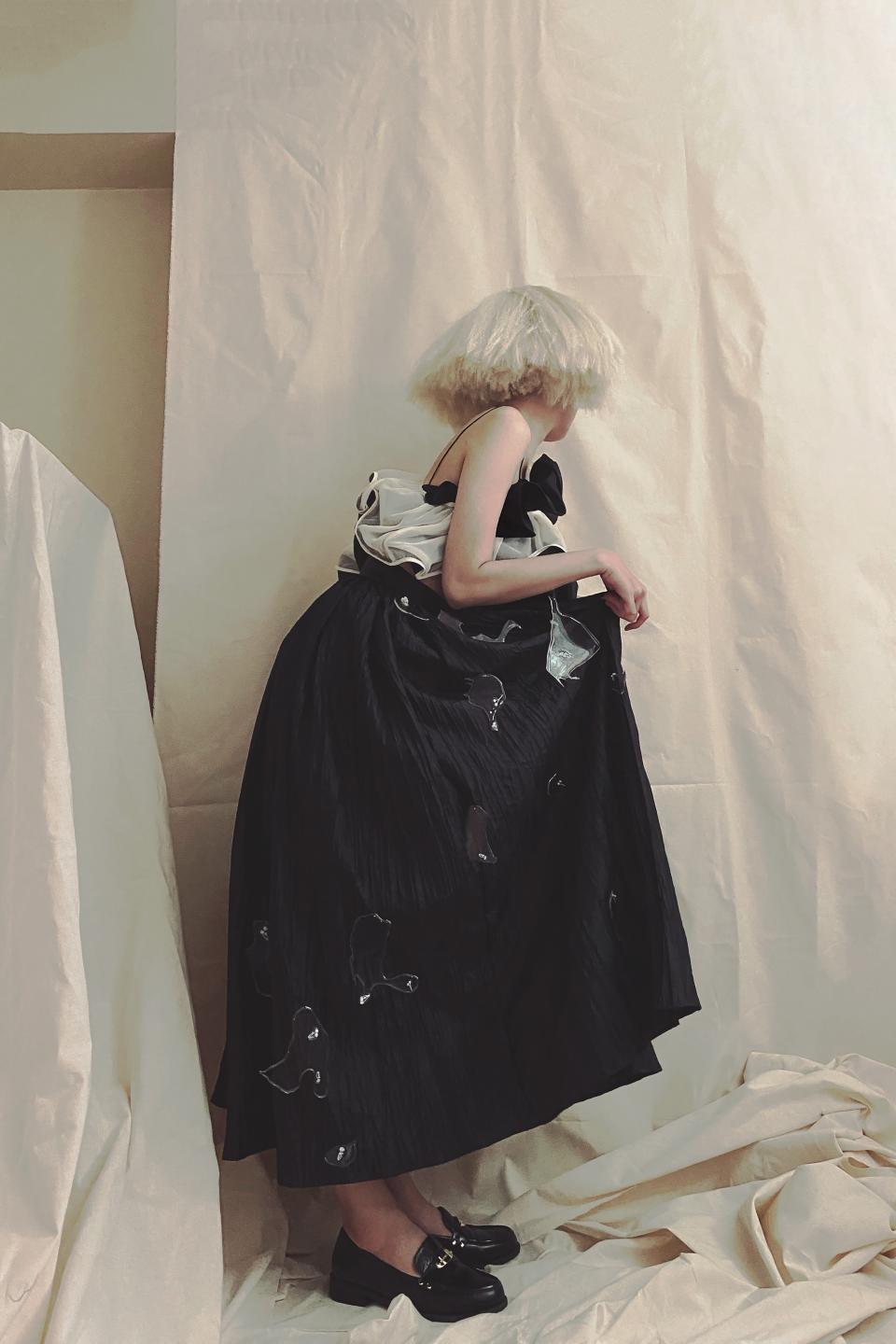
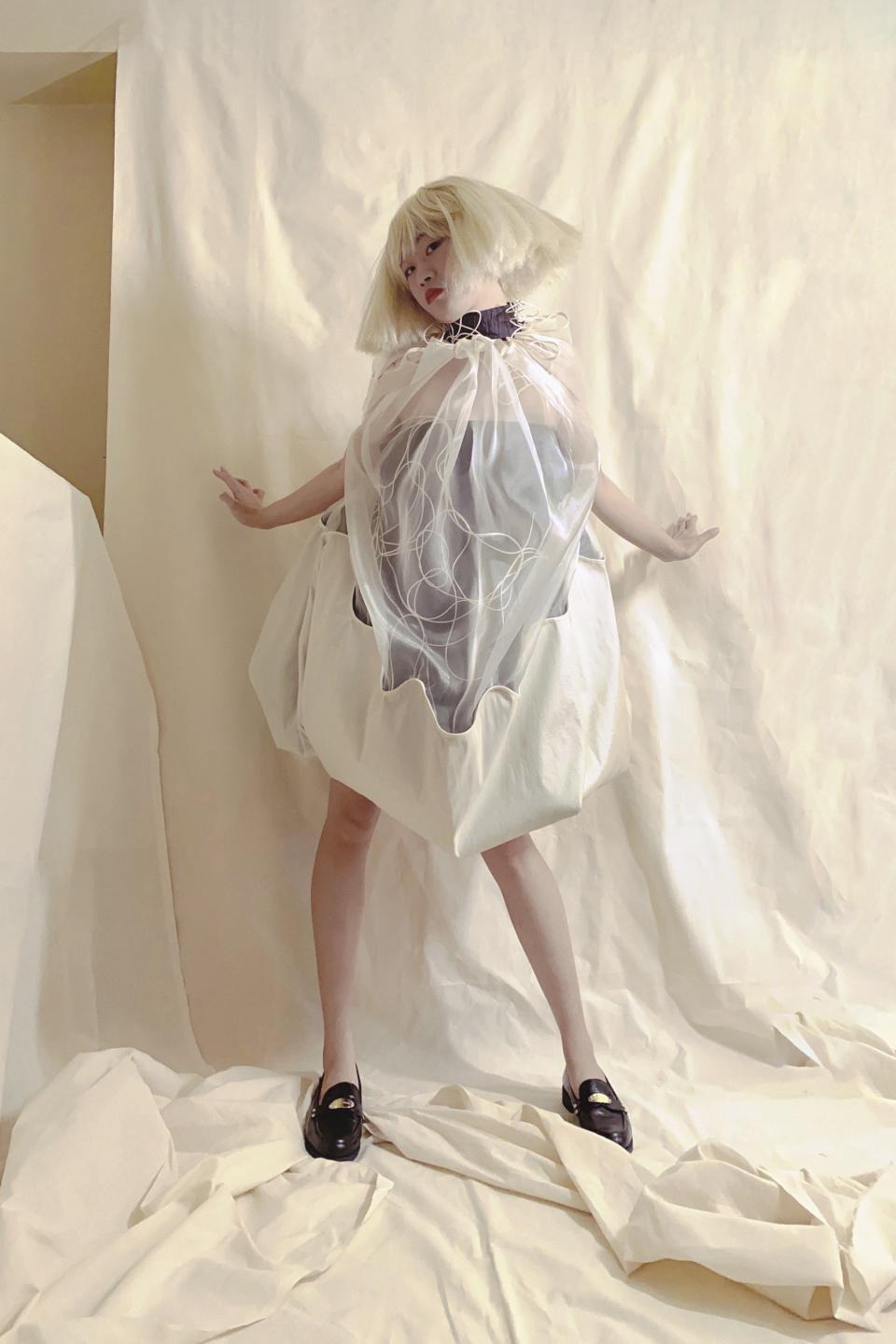
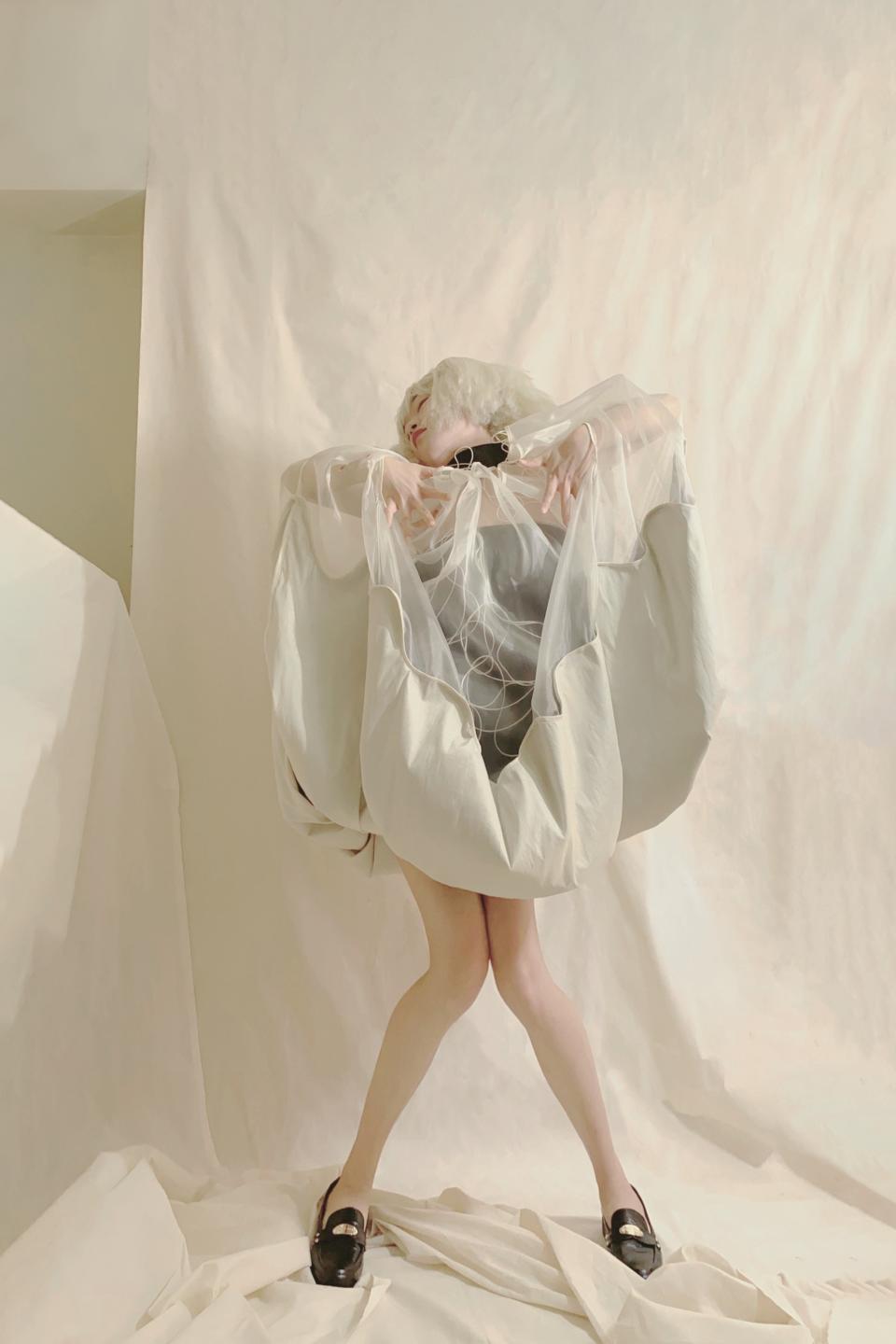
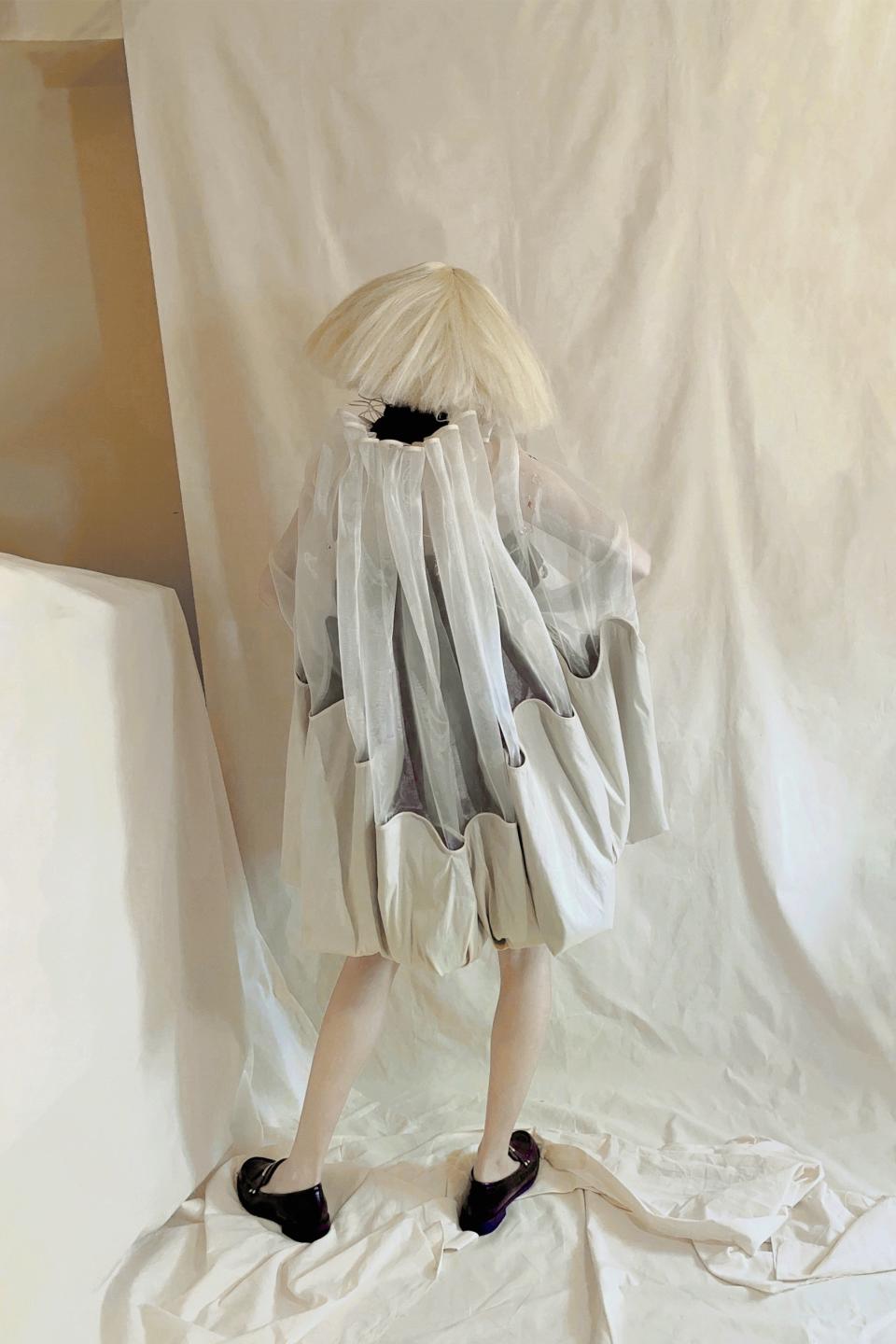
Jiayu Lin, 24, from Fuzhou, China; @vncircle
Tell us about your looks.
This collection represents the juxtaposition of innocent elegance and sinister sensuality. The main colors are cream and black. These conflict colors present feelings of naivete and wickedness. The first look is a combination of a one-shoulder crop top and extremely loose pants. The top is in beige micro-pleated polyester chiffon and black taffeta, featuring a released pleated edge and two layers rolled-inside design. There are several handmade resins with silicone mushrooms scattered in the front of the pants [that[ are inspired by a deadly fungus called Destroying Angel. People usually eat them by mistake due to their natural appearance. Transparent resins have a clear and pure appearance, tricking people into believing they see everything, but actually they do not. The dark mind is hidden.
The second look is a knee length dress featuring a patchwork of cream crystal organza and double faced taffeta, which are cream satin and black crushed. A puff bustline design with elastic bands connects a gathering big loose dress. Cords on the dress enchantingly interlace together to make a net that captures people’s hearts. Tie-up closures are placed at the sides of the neck. Loose organza pleats are stitched around the neck. This look is decorated with a little red, a color that subtly exudes a sense of enticement and danger. Several resin artworks painted by a touch of red ink are scattered on the organza and are hidden by the loose pleats. They show bit by bit when the wearer moves.
Describe your aesthetic in 140 characters.
I am pursuing a perfect balance between sophisticated sexiness and playful innocence to show cute youth in a seductive and elegant way.
What challenges did you face in the pandemic, and how did you overcome them?
The biggest challenge I faced was my attitude. This unexpected pandemic has changed the mode of people’s lifestyle. As a student, it was the first time I was faced with complete remote learning. In the beginning, I doubted my own capabilities, and wondered if I could complete my thesis collection through virtual help. But virtual learning was not as bad as I thought. Due to the quarantine, I stayed at home for a long time. My biggest form of entertainment was the internet [and] I discovered many little-known things about the world through it [that] expanded my horizon and inspired me to create a unique collection. Looking back, I realized I may have caused my own stress. Actually, every cloud has a silver lining. There is no need to be afraid of the unknown and inadaptation. Things will eventually work out when people let and go and accept life’s circumstances.
How would you like to change fashion, if you could?
I’m obsessed with discovering and researching unconventional materials and making them to be worn comfortably. I hope my designs can break the stereotype of clothing, that it is only a combination of fabrics, yarns, fur, beads and feathers. The world is full of novelty things that I can convert into untypical and unusual materials to make garments. As a designer, I do care about the feeling of wearers, so I’m enjoying exploring a way to keep unconventional materials outstanding and make them wearable.
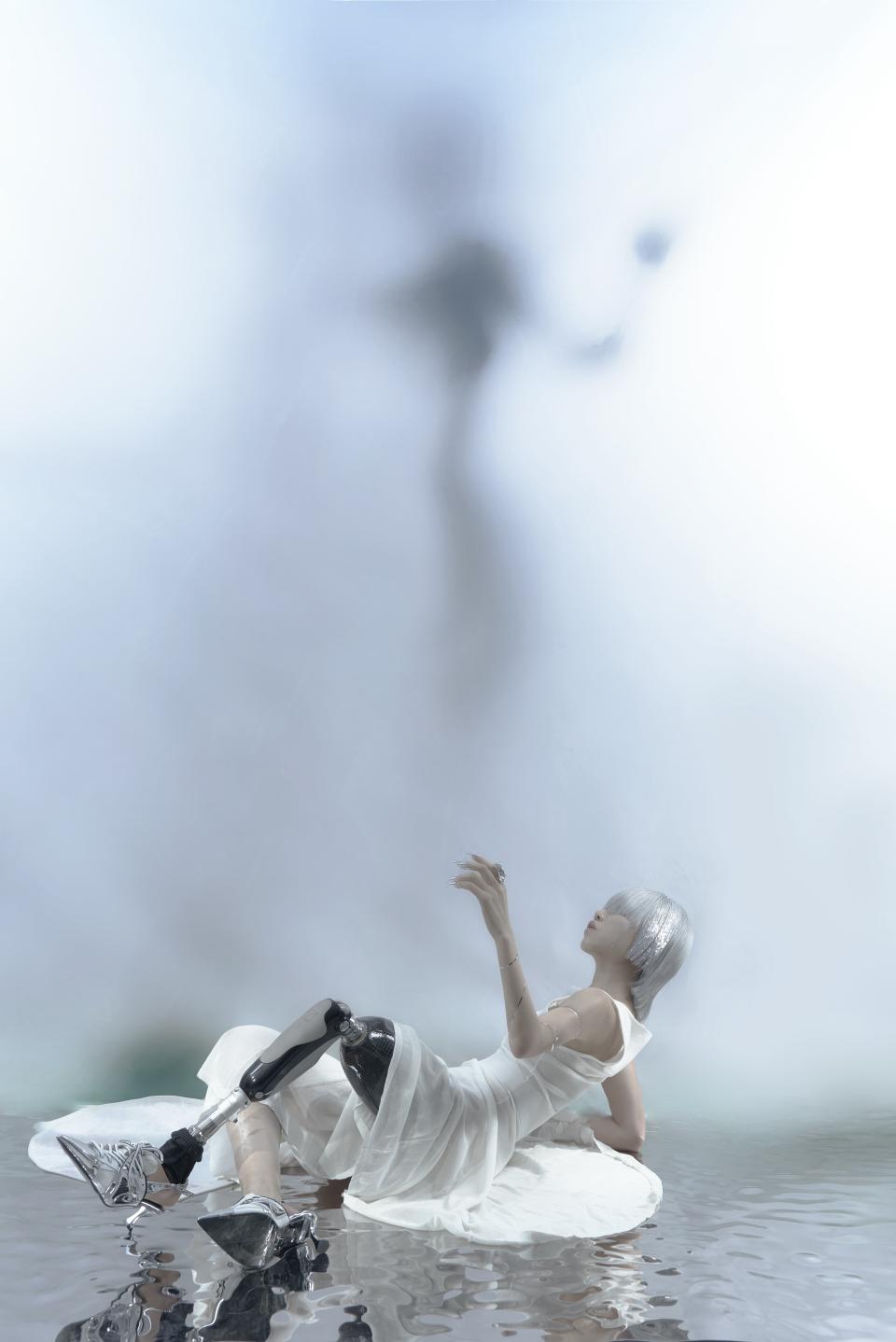
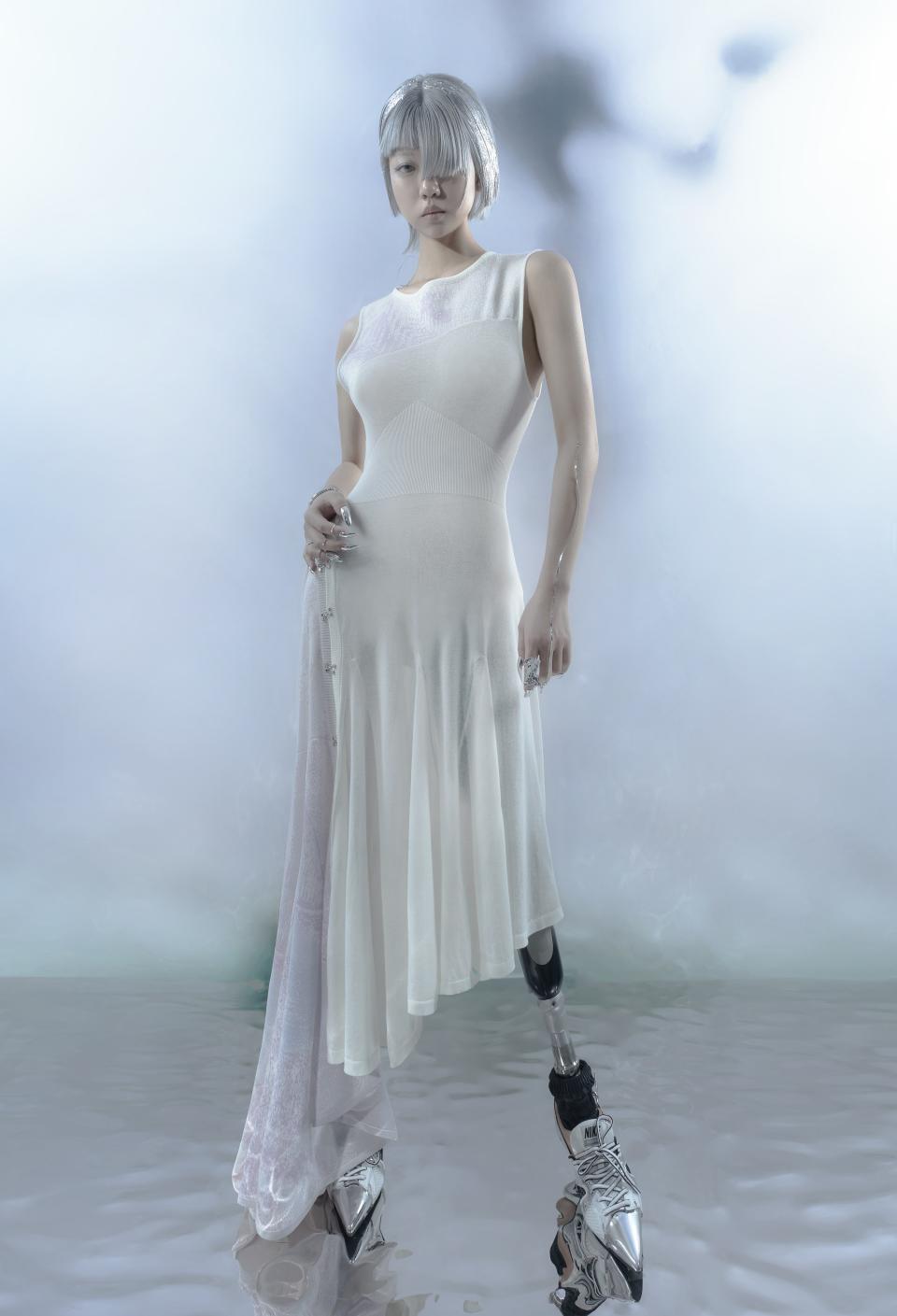
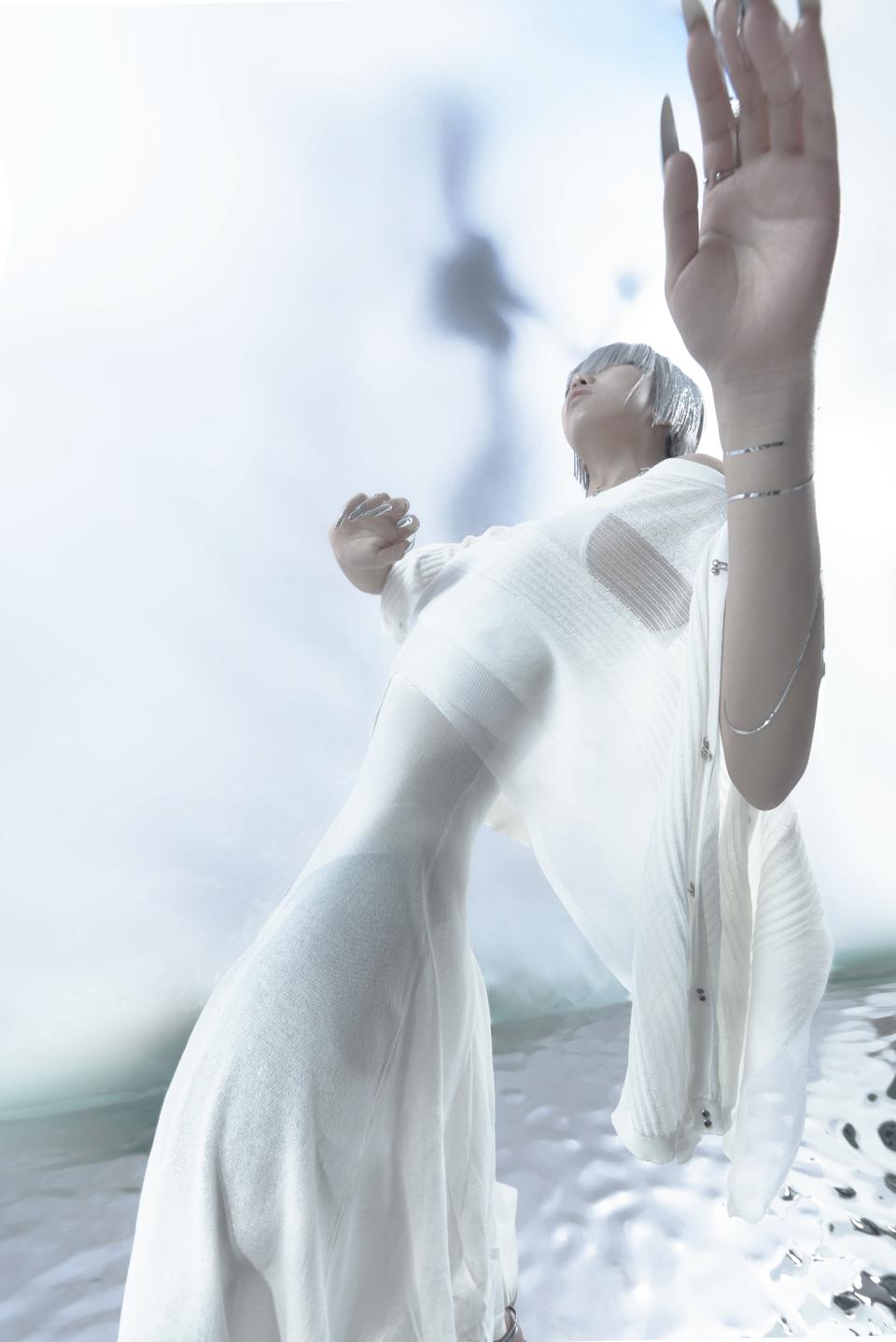
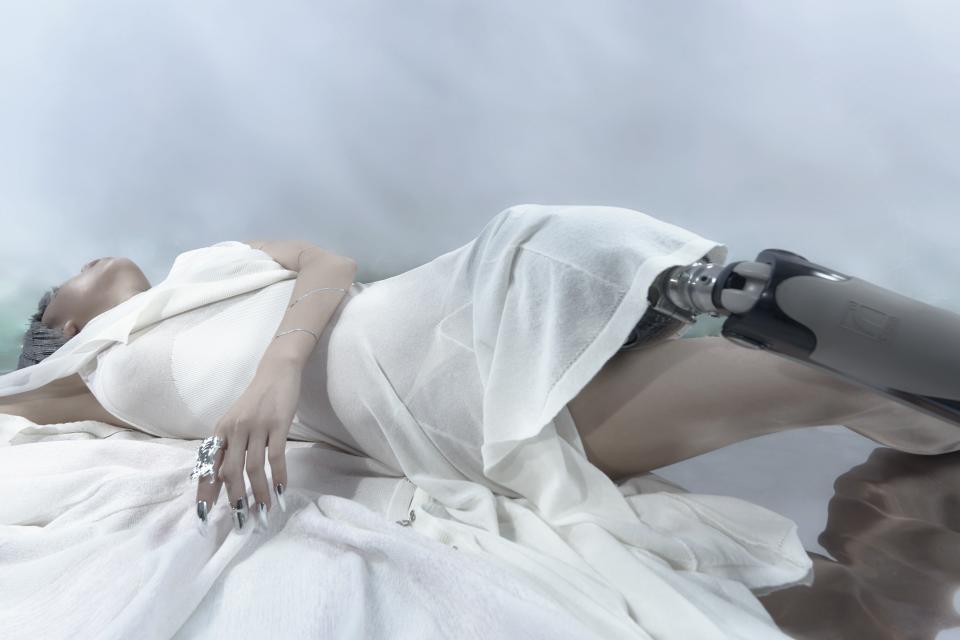
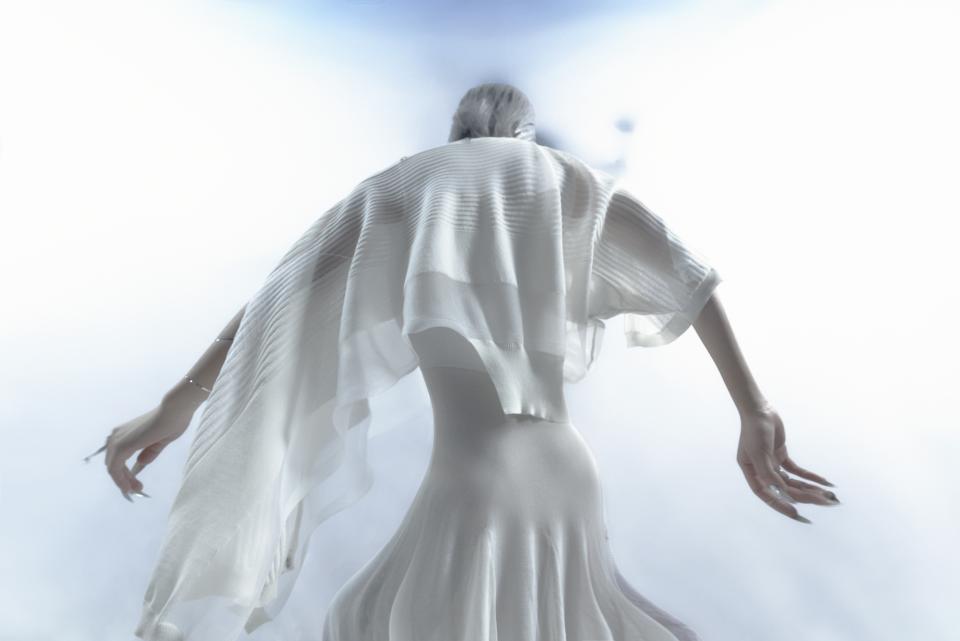
Jinjing Lin, 21, from China
Tell us about your look.
My collection, WE ROBOT, narrates a fantasy about how all humankind is artificial intelligence robots aka “humanoids.” I explored tech yarns—such as UV color change, antibacterial, and sustainable yarns, like bamboo or Bazelon— throughout my design process to show what future knits will be like on humanoids.
My goal was for the knitwear to appear as a lightweight fluid extension or second layer of a humanoid’s body. The idea of using crème fine gauge, fully fashioned gored with asymmetrical hem required many knitting techniques. The dress features a detachable jacquard panel knitted by UV color-changing yarn. Additional color-changing pattern areas were placed throughout the style.
The jacquard effect changes when UV radiation intensity changes. It makes the whole garment become a future-like moving picture.
Describe your aesthetic in 140 characters.
I like to find the beauty and balance between technology and nature. I want to try my best to create sustainable and eco-friendly fashion.
What challenges did you face in the pandemic, and how did you overcome them?
Knitwear is quite different from other concentrations, it requires machines in many ways. After the pandemic forced the school to close, we no longer had access to our yarn lab, the professional knitting machines, and our technical support from the school, so everyone in my concentration, knitwear, learned almost everything from the Internet and YouTube. Since this was my second year learning remotely, and since I live in Asia, it was not possible for me to use the machines in school and test the swatches. It was indeed challenging. However, we all felt much more satisfied and accomplished after we finished everything at home. I have to say that me and my classmates overcame all the technical problems by our passion for knitting. Our love and dedication to knitwear allowed us to get through remote learning during this challenging time. It was such a precious learning experience.
How would you like to change fashion, if you could?
By offering employment opportunities for the knitters and herders in the Tibetan area in China. What I did in my previous collection was use sustainable wool materials from the [there], which provided work for their native people. If I can have the opportunity of doing wool knitting production for my designs in the future, I can provide secure jobs for households and women in the area hand-weaving and knitting. Approximately 6,000 sheep and 1,500 yaks would be removed from the plateau, resulting in reducing the burden of overgrazing on the grasslands. In the meantime, compared with other fabrics like cotton, natural yak and sheep wool do not require the use of pesticides at all, so the garments made using these materials are very sustainable and durable. I wish I can push sustainable fashion a little bit further and show the world the glamour of Chinese ethics.
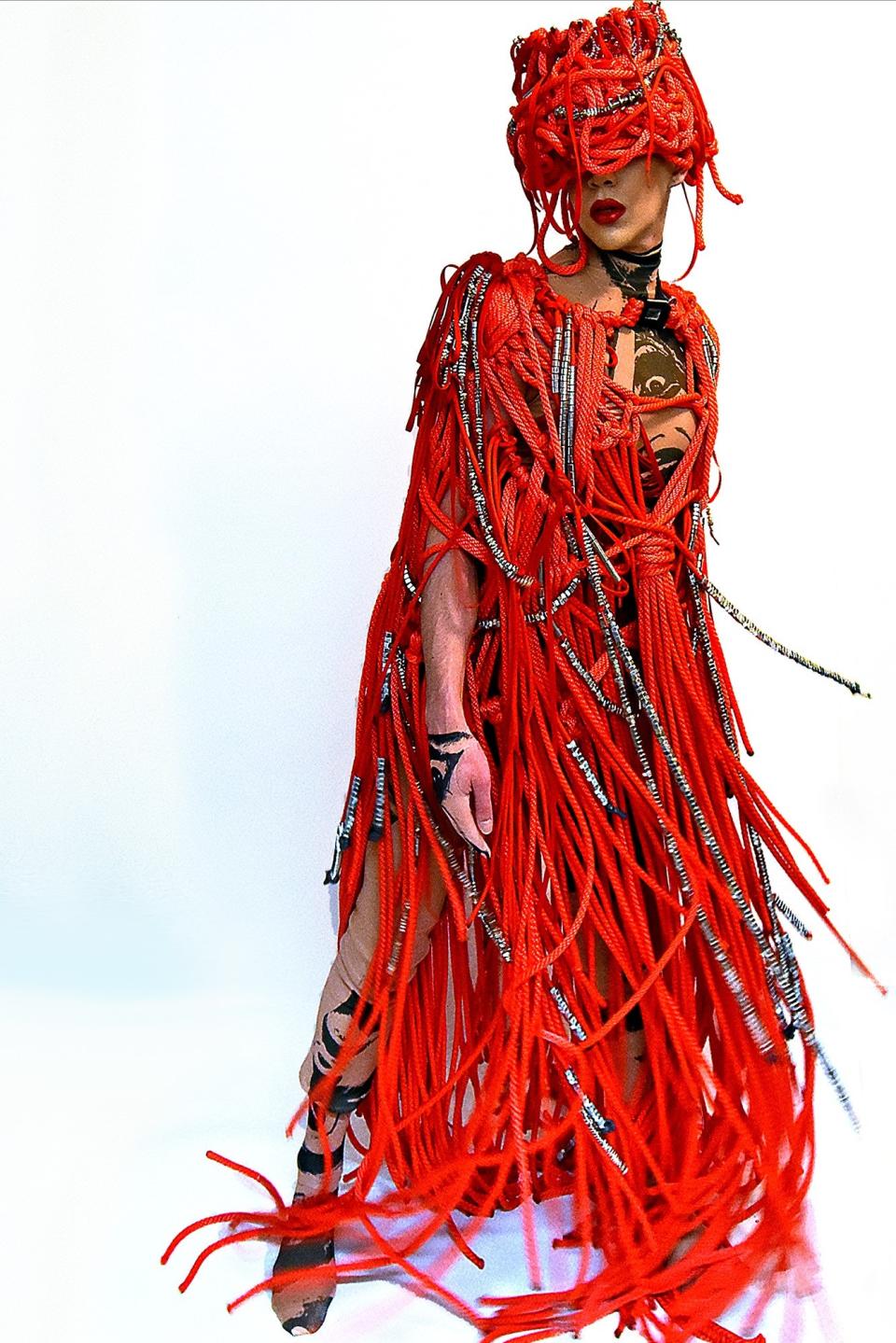
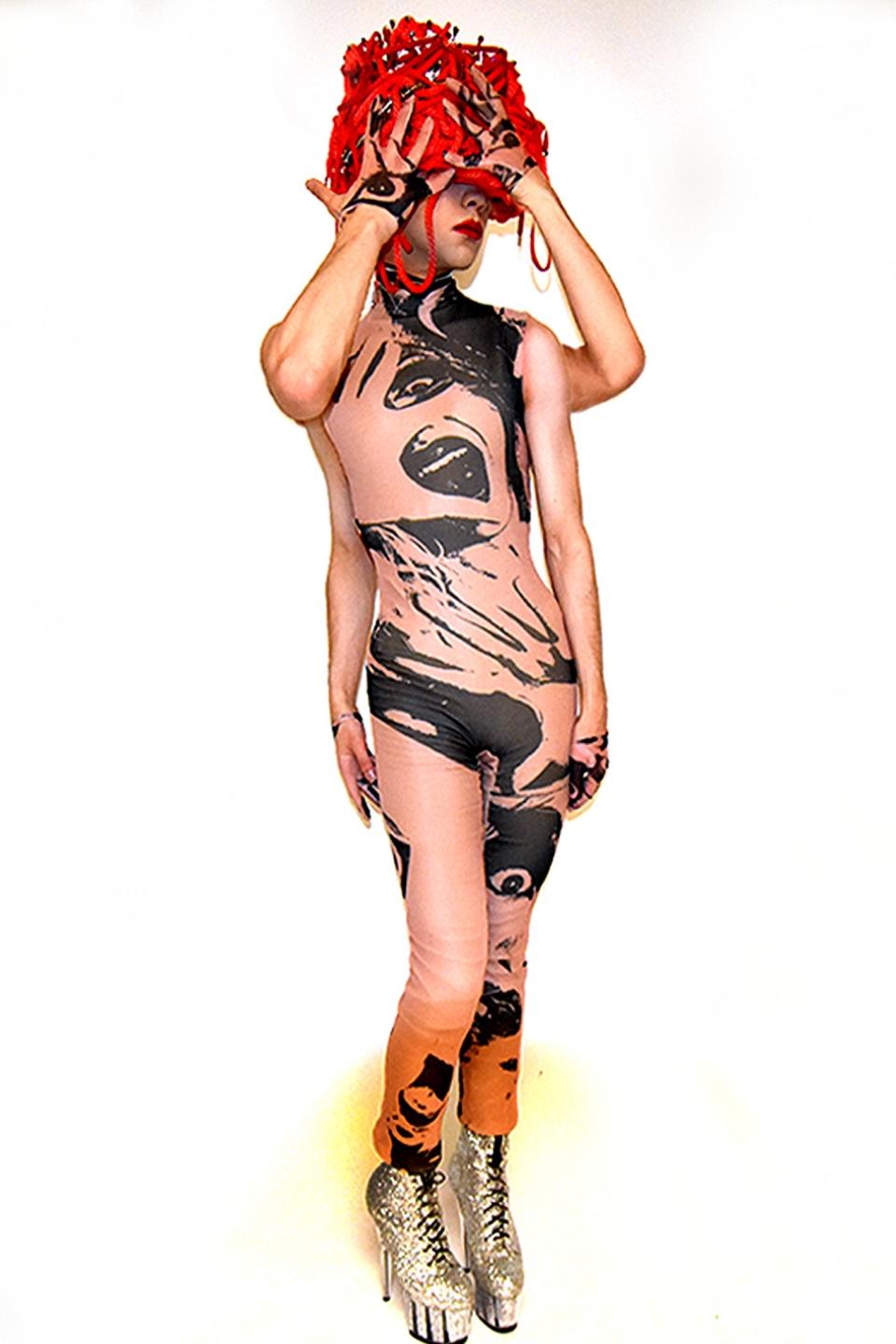
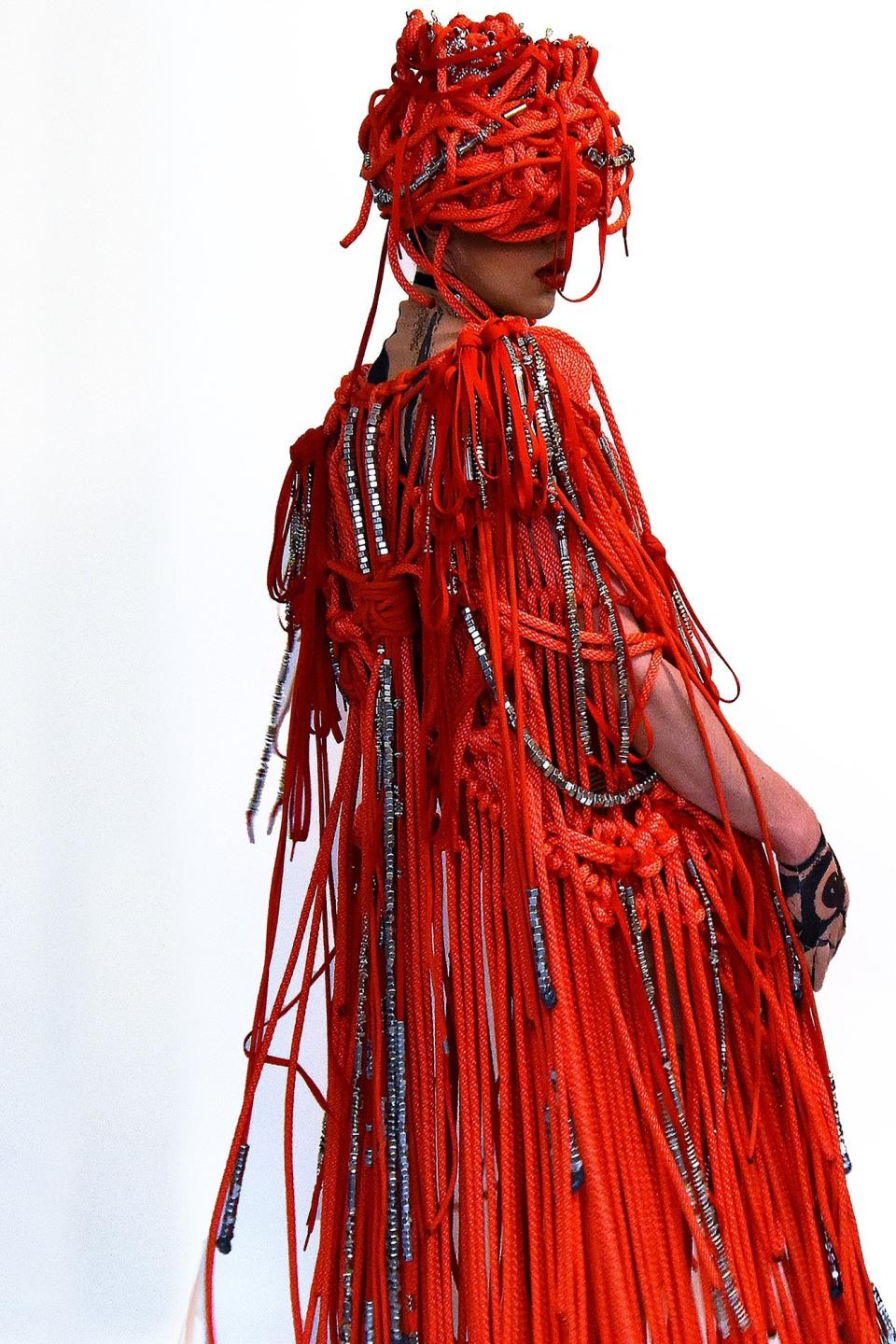

Steven Panoncillo, 22, from Sunnyside, NY; @booboo.nyc
Tell us about your looks.
The focal piece of my thesis collection is a massive macrame gown made out of over 1500 yards of nylon rope and shoelaces. Beaded with hex nuts and other pieces of hardware, the piece pulls inspiration from shibari rope techniques and makes the wearer look like an industrial fringe cryptid that appears in your dreams. Underneath the macrame is a single-cut catsuit made of printed power mesh. I utilized an engineered print with photos of my face screaming so that as the catsuit is revealed by the moving macrame, certain facial features become visible. The other looks in the collection include a variety of custom printed fabric chronicling the distortion of identity I faced as I first developed my drag persona.
Describe your aesthetic in 140 characters.
In a Cindy Sherman-esque fashion, I use my drag identity to play different characters. Each look I design is a separate role to step into.
What challenges did you face in the pandemic, and how did you overcome them?
I was very privileged to have a dress form and sewing machines in my apartment before the pandemic struck, and I am extremely grateful that I did not have to change living situations or scramble to get a sewing machine when school was forced to close. Most of the challenges I faced were in my own head. Self-doubt is never a quiet housemate, and when you’re stuck at home all the time you get used to that voice for sure. Not being able to be in a studio space working alongside my peers, I started to doubt that anything I was creating had any substance. I’m not sure you could say that I’ve overcome this challenge, but I definitely have gotten better at putting in my headphones, listening to Untouched by the Veronicas, and tuning out that self-doubt.
How would you like to change fashion, if you could?
Fashion needs to change by lifting up and promoting emerging marginalized designers. The pandemic slowed down the fashion life cycle and gave big brands more than enough time to think about what is wrong in the industry and how to reconfigure. Still, independent brands started by women, LGBTQ+ individuals, and POC have their work stolen by bigger brands or swept under the rug by the algorithm on Instagram. Collaboration is the future in all creative industries, and it is crucial for major brands to not only amplify but to give space for female, disabled, LGBTQ+, Asian, plus sized, and BIPOC creatives to tell their stories in their own ways.
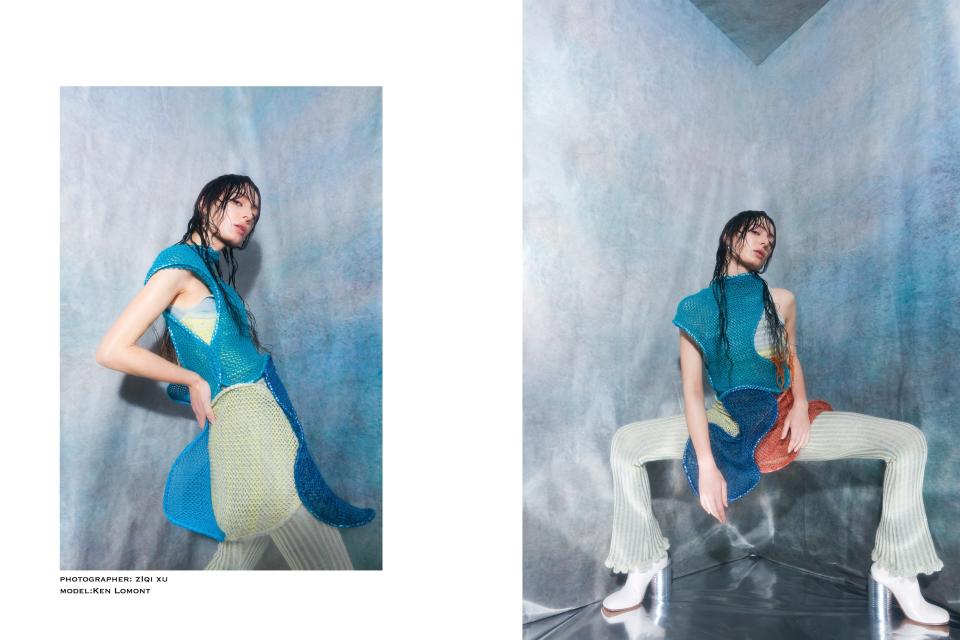
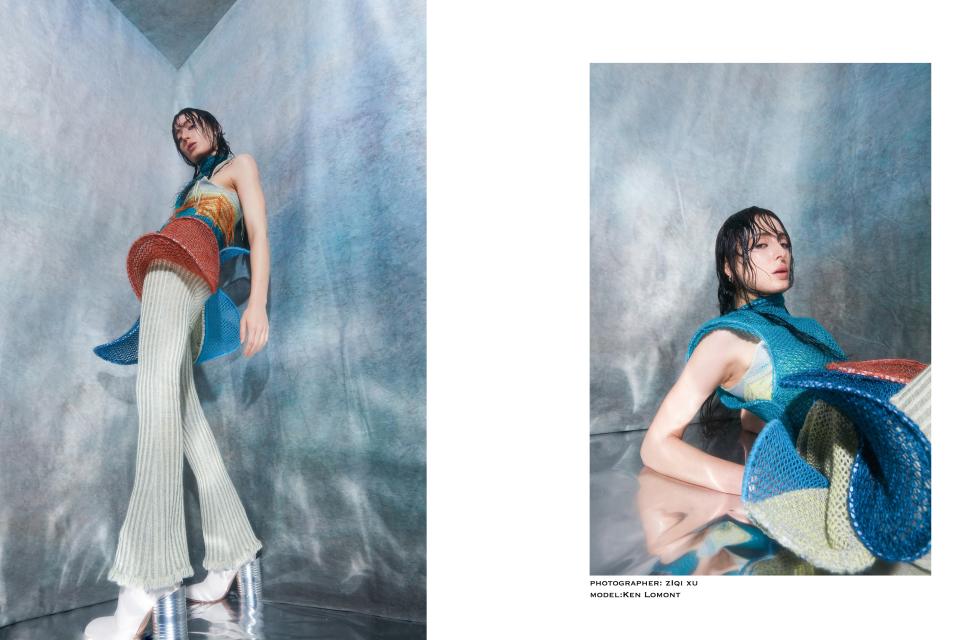
Jialing Shen, 27, from Shanghai, China
Tell us about your look.
The dress I’ve designed is hand knit pointelle stitch and three-dimensional stretched with boning panels in six shades. The textural tank top underneath was fully fashioned and developed using a “weaving technique.” The flared pant is a bicolor cardigan-stitch piece knit done entirely on a Stoll Industrial Power Machine.
Describe your aesthetic in 140 characters.
My aesthetic is largely influenced by my fine arts background from China. Sometimes to create the forms I envision, I must problem solve against gravity and explore beyond traditional construction methods.
What challenges did you face in the pandemic, and how did you overcome them?
A huge hurdle I faced was not having hands-on experience with the industrial knitting machine at school. The online format for knitwear design pushed me, other students, and faculty, to reevaluate the design process. Fittings through Google meetings was especially difficult for the lack of hand feel, [and the] communication needed to be precise to convey subtle changes. Though I missed out on using the industrial machines at school, I used a home knitting machine to explore more intimately different hand knit and crochet techniques. The design side of my brain began to see more solution-based paths to take as roadblocks appeared.
How would you like to change fashion, if you could?
Fashion needs more equity. Conversations of race and gender-equality need to be acted on from executive to entry level environments. The question isn’t always what I can do to change the fashion industry, but what individuals in positions of power can do to change it. My message to them would be to listen to the new generation and give them a platform not only to speak up, but positions where they can enact real change.
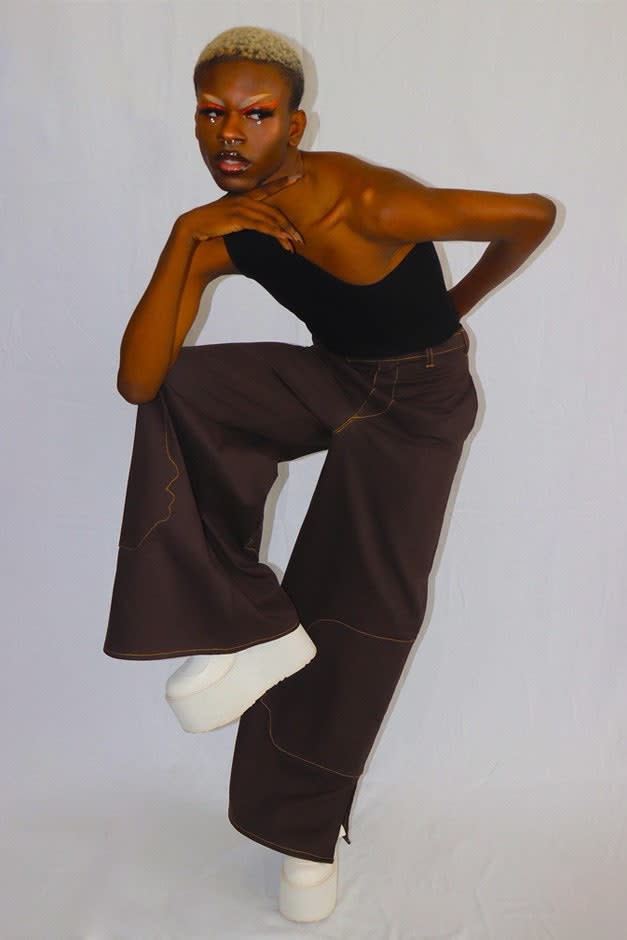
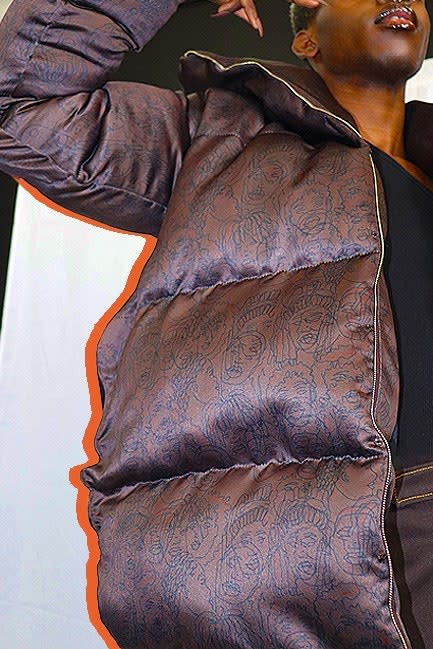
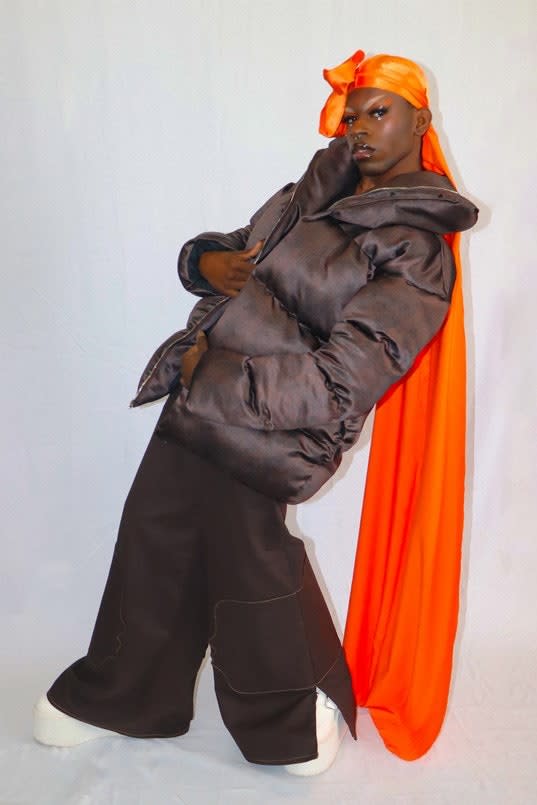
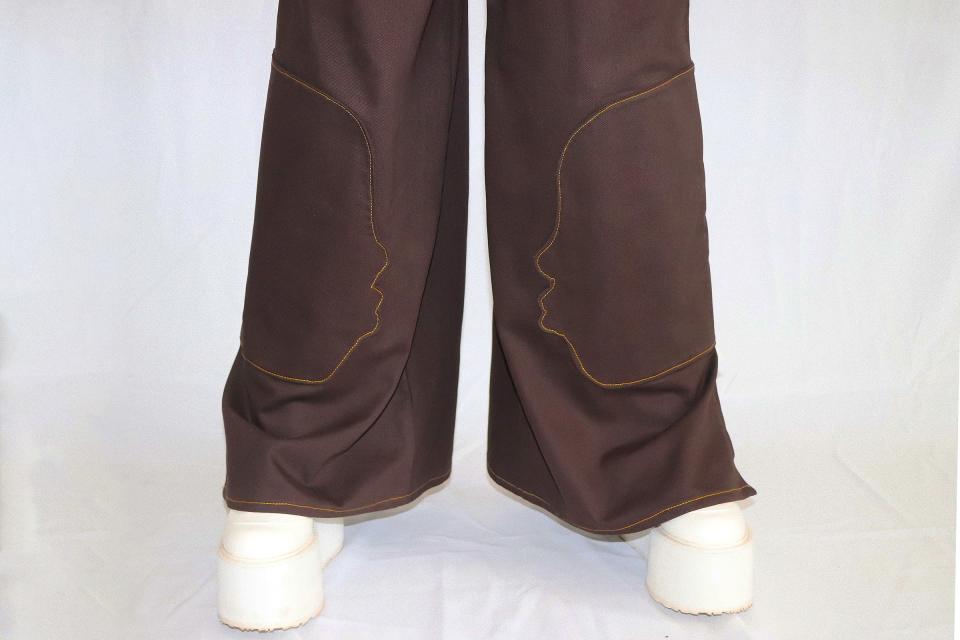
Darnisha Thomas, 22, from East Orange, NJ; @dajournal_
Tell us about your look.
This look consists of a printed duchess satin puffer coat, featuring a shawl collar, rib-knit asymmetrical top, denim pants with facial profile detail, and an elongated stretch charmeuse satin durag. I designed the print on the puffer coat. It’s called, I See You, You See Me, [and] was inspired by the many faces of Black folks from far and wide.
Describe your aesthetic in 140 characters.
My inspiration is drawn from feminine and masculine silhouettes while fusing my love for fine arts, music, and vivid hues. I strive to create designs that are accessible to all.
What challenges did you face in the pandemic, and how did you overcome them?
My sense of control kind of flew out the window once the pandemic took hold of us. Anyone who knows me knows how much of a freak I am about order and consistency. (Big Capricorn Energy!) There was so much that changed throughout this whole ordeal, and it heightened some anxiety for me. Seeing where things were heading, I knew I had to get myself back together somehow. I tapped into yoga and meditation as a way to ground myself and reassure myself that things would get better. I’ve learned to really trust myself and believe that I had to honestly release that dependency of needing to be in control of everything in my life. I’ve also ventured into reading more and watching a crazy number of cartoons to escape reality sometimes. Nowadays, I just go with the flow and see where the Universe takes me. I think I’m doing a pretty good job at it!
How would you like to change fashion, if you could?
Given the opportunity, I would reimagine the conceptions of what is expected in the eyes of society. I know it may sound cliché, but today there is still a long list of standards on what someone should wear, behave, think, speak. Fashion is an entity that plays a part in this. I see fashion as a means of experimentation. Fashion has always been one of the catalysts of my deepest means of expression. I’ve always believed that people should have the right to express themselves regardless of social expectations fully. I love seeing people have fun with fashion in ways I never imagined. These types of fun expressions allow us to experience a world of possibilities.
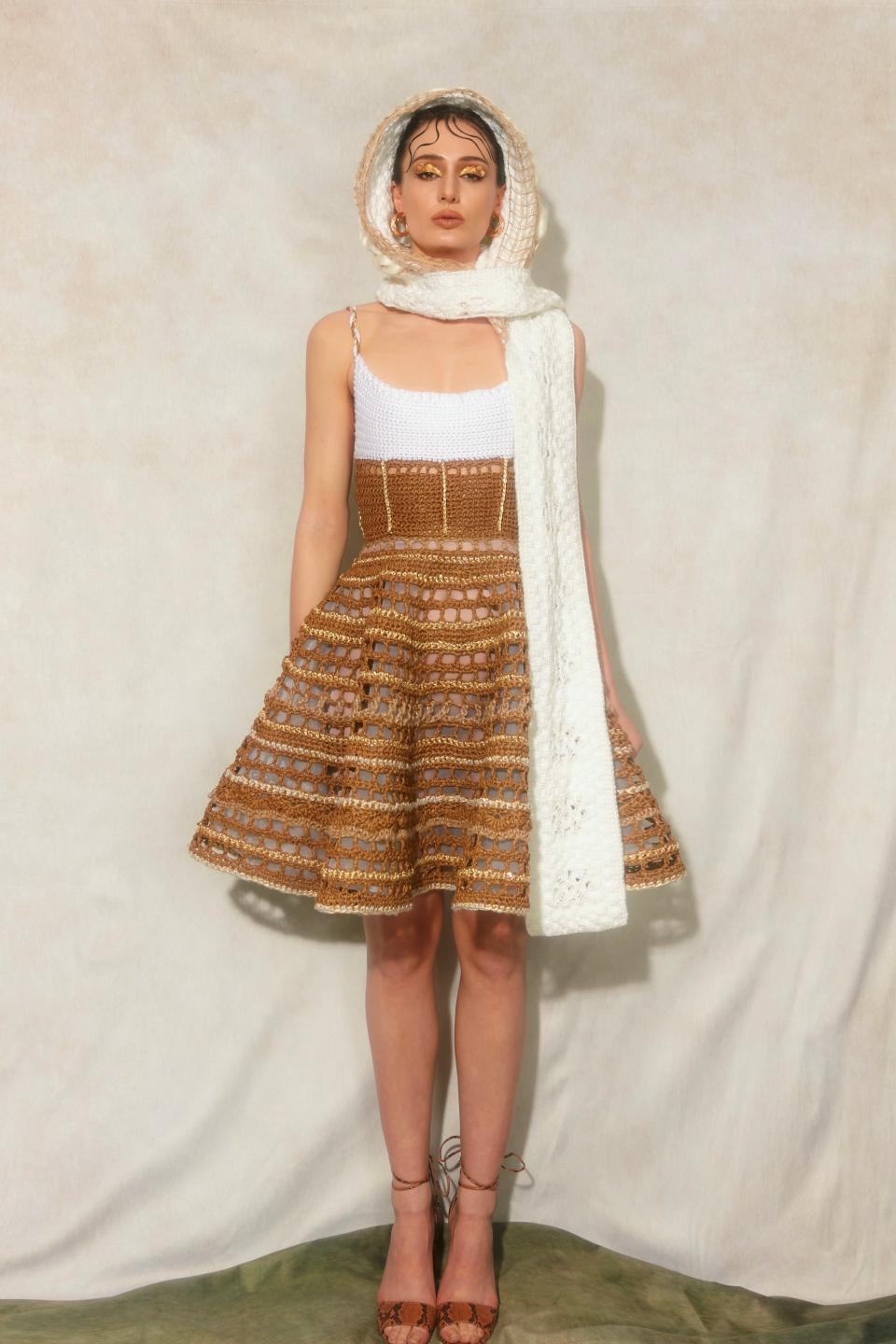
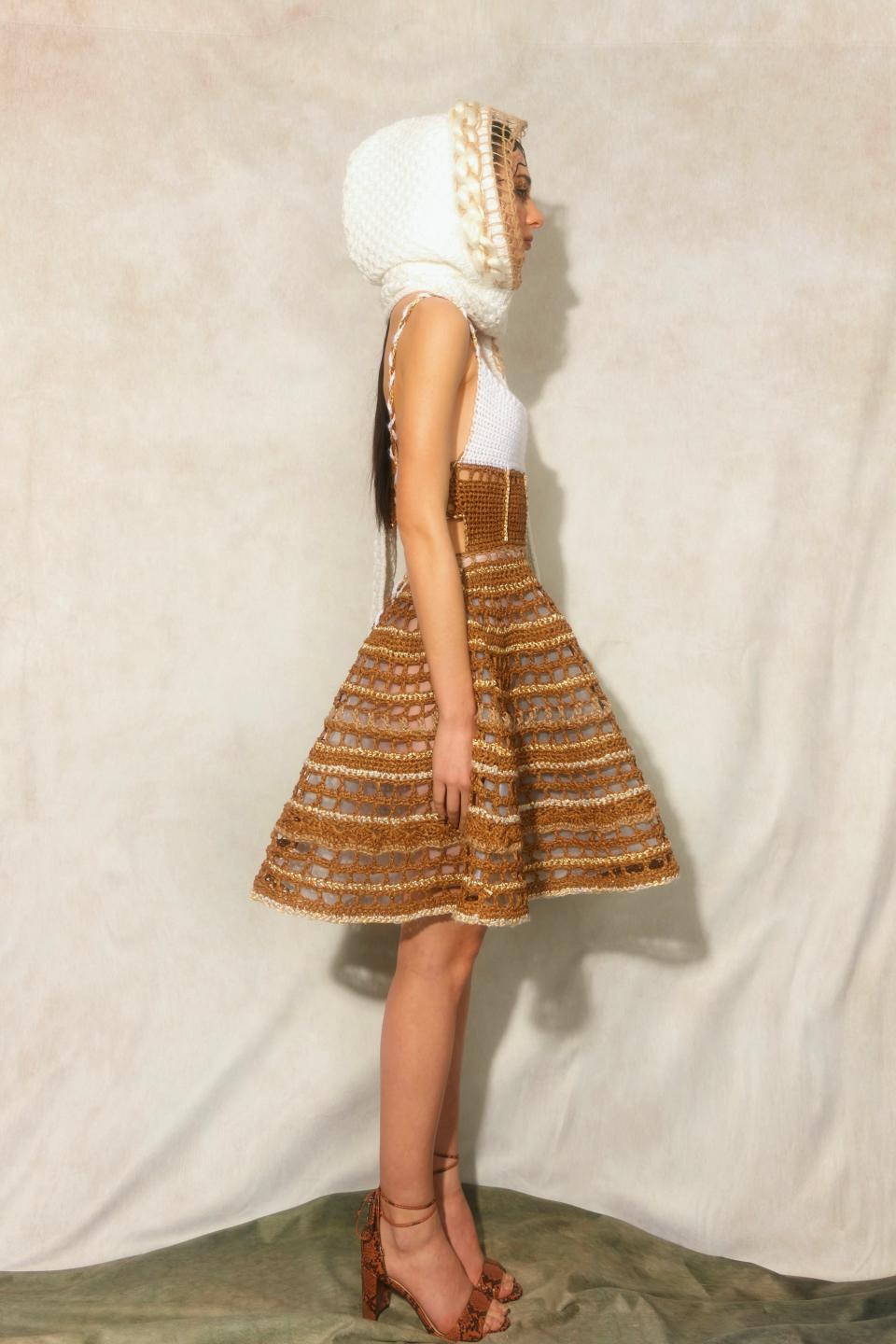
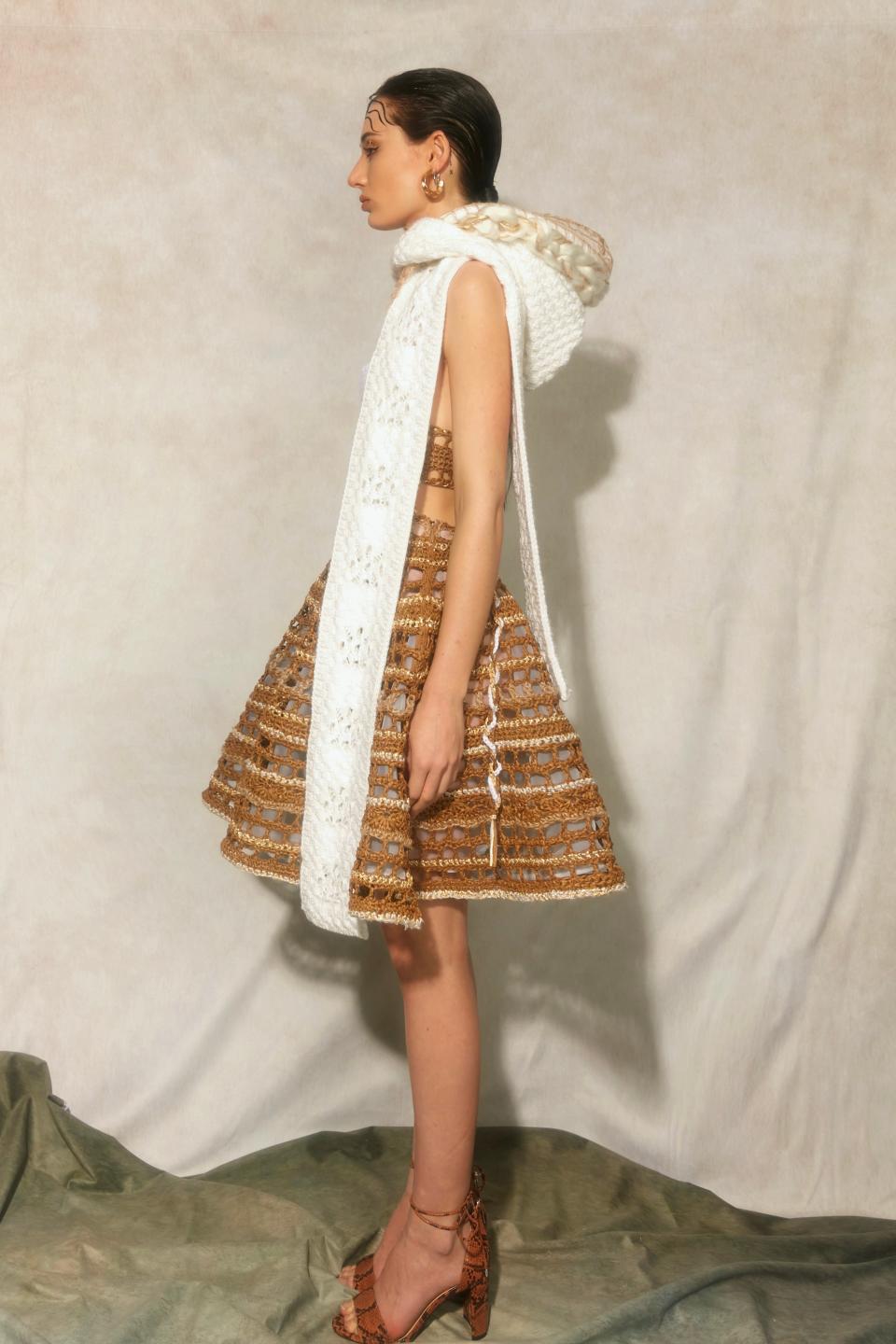
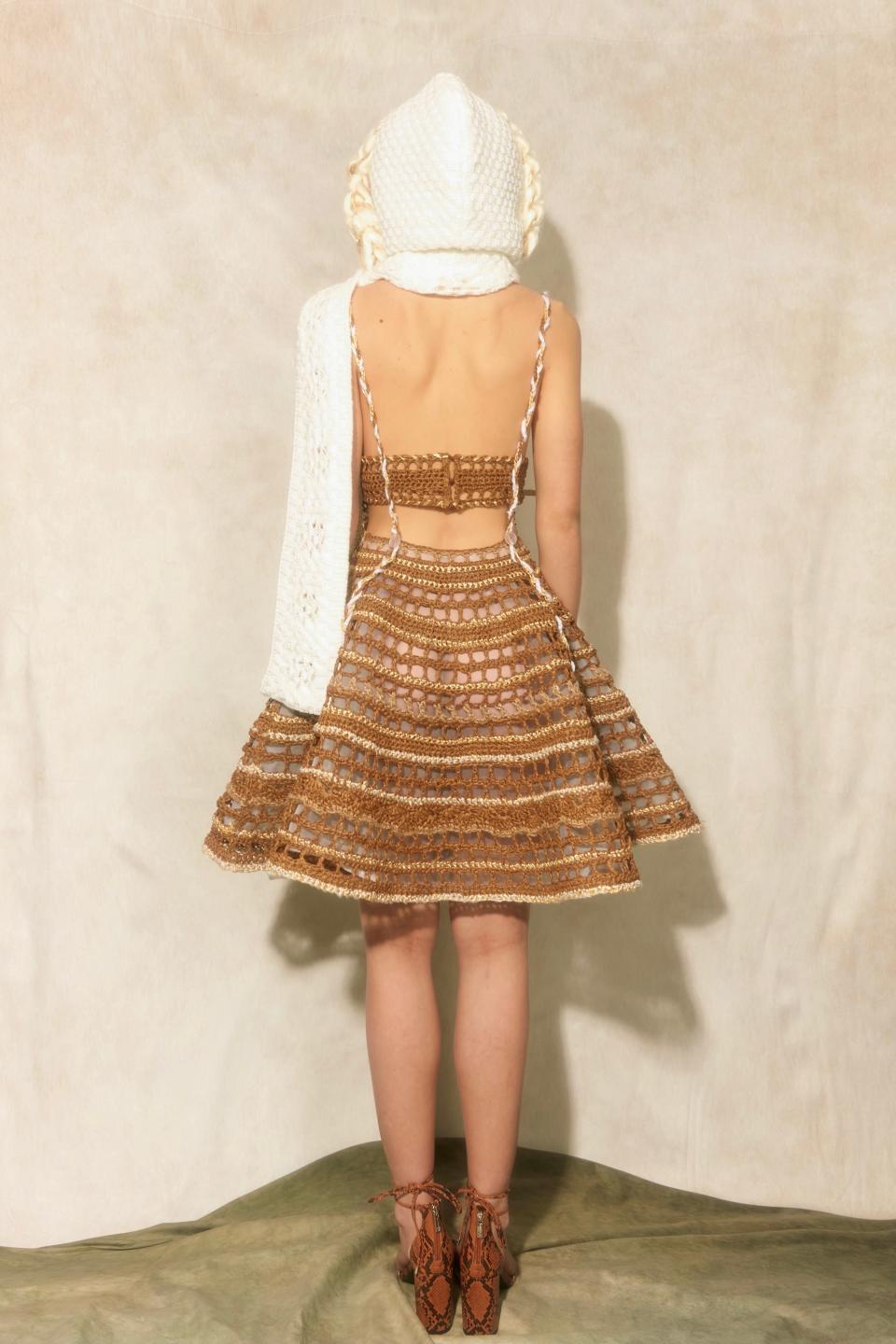
Ziyue Zhu, 23, from Nanjing China; @clarebola_
Tell us about your look.
The whole look is inspired from the rich and diverse middle eastern culture, incorporating elements of Arabic architecture, colors, and geography. The dress was hand crocheted by raffia yarn, using various crochet techniques. The hooded scarf was knitted by a Stoll machine using purchased bamboo yarn.
Describe your aesthetic in 140 characters.
My design aesthetic combines youthfulness with elegance and sophistication, with the goal of making women feel both empowered and excited.
What challenges did you face in the pandemic, and how did you overcome them?
One challenge I had was sourcing the materials for my thesis collection. Since everything had to be ordered online, it was difficult to find the fabrics that worked best since I wasn’t able to see, feel, or measure in person. This was one of the reasons why I chose raffia yarn, because unlike other yarns, I knew what kind of texture to expect. Another challenge I had was finding alternative ways to design and construct my garments due to the inaccessibility of some of the equipment that was available at school. I overcame these problems by researching other techniques online through various websites, blogs, and videos which provided me with solid solutions.
How would you like to change fashion, if you could?
One of my biggest passions in fashion is a focus on sustainability. I believe this is heavily reflected in the materials that a designer chooses to work with. For example, I decided to use both bamboo and raffia yarns as my primary materials in my dress. Both bamboo and raffia palm trees are fast-growing crops that are eco-friendly and non-animal sourced. They are also strong, durable, and pliable materials that can be dyed easily. My approach to fashion is to change the industry by encouraging companies and designers to incorporate more sustainable materials and techniques into their clothing in order to make the world a better place.
These interviews have been edited and condensed for clarity.
Originally Appeared on Vogue

